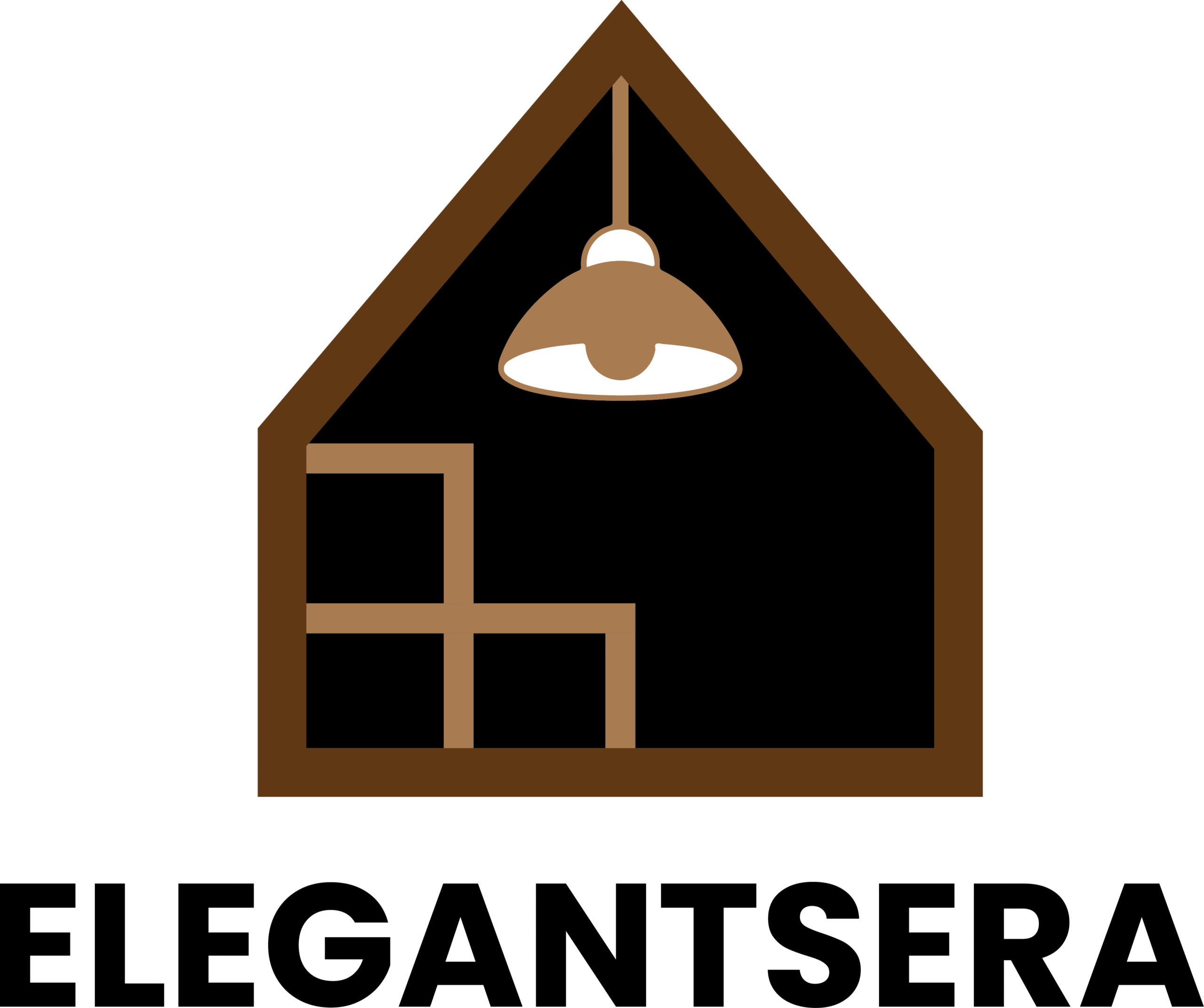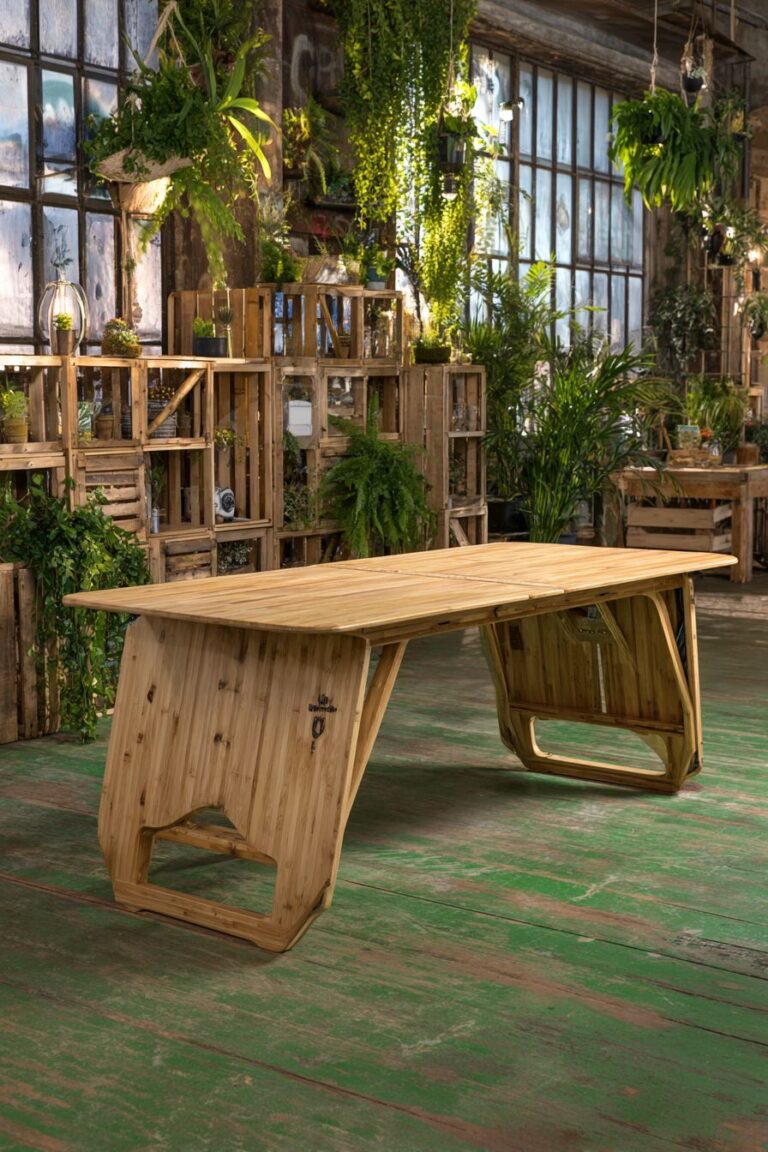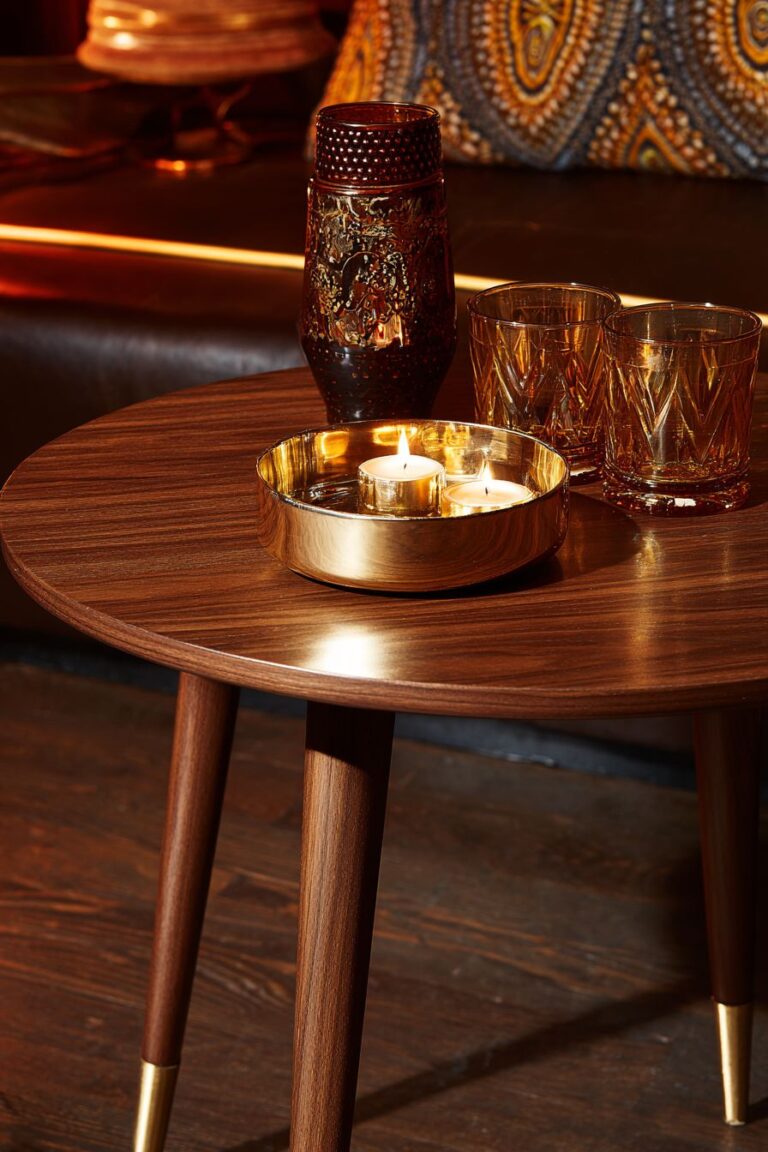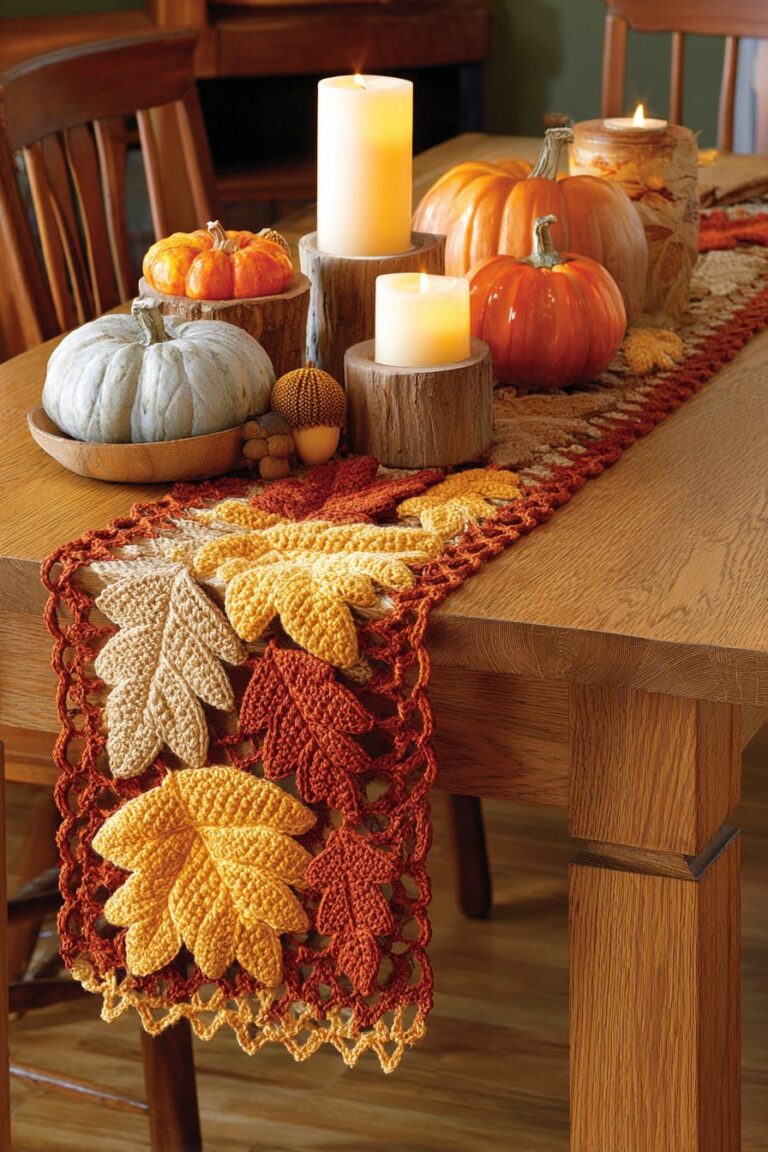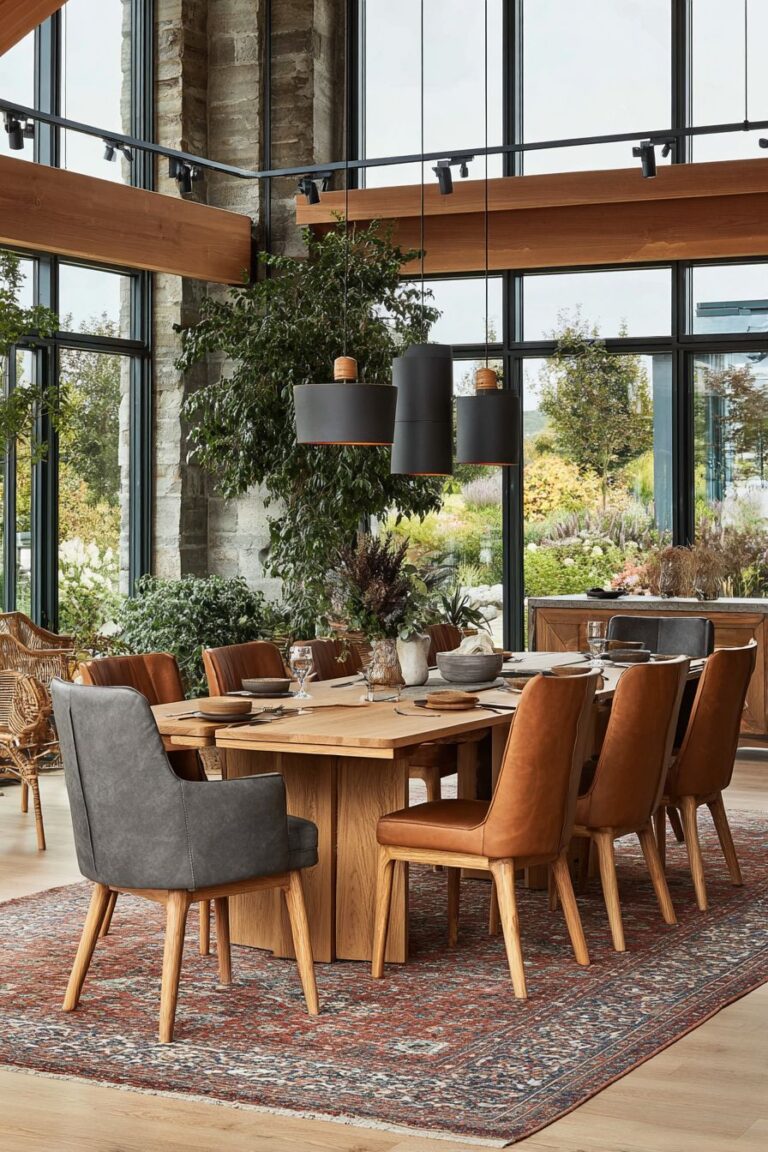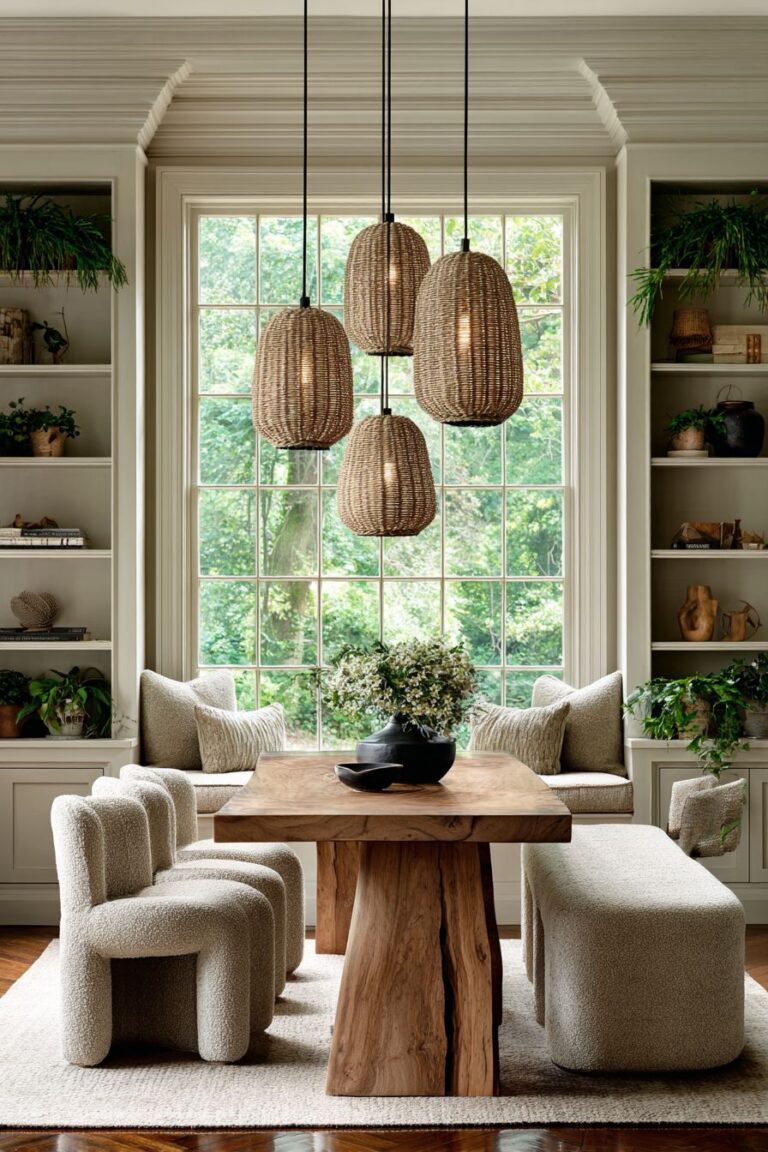20 Timeless Old Money Dining Room Ideas: Designs That Embody Sophisticated Elegance
The concept of “old money” in interior design transcends fleeting trends, representing a sophisticated approach to decorating that emphasizes quality over quantity, heritage over novelty, and understated elegance over ostentatious display. In the dining room—perhaps the most formal and socially significant space in any home—old money aesthetic principles create environments that feel both luxurious and lived-in, sophisticated yet comfortable. These spaces tell stories of family traditions, careful curation, and an appreciation for craftsmanship that has been passed down through generations.
Old money dining rooms are characterized by their emphasis on natural materials, classic proportions, and timeless color palettes. Rich woods like mahogany, walnut, and cherry form the foundation, while fine textiles in muted tones of navy, forest green, cream, and burgundy add warmth and sophistication. Crystal chandeliers cast soft, ambient light over tables set with heirloom china and sterling silver, while Persian rugs anchor the space with intricate patterns that have remained beautiful for decades. The overall effect is one of refined comfort—spaces that are impressive without being intimidating, elegant without being cold.
In this comprehensive exploration, we’ll examine twenty distinct approaches to achieving the old money dining room aesthetic, each offering unique insights into this timeless design philosophy that continues to inspire discerning homeowners seeking to create spaces of enduring beauty and sophistication.
1. Rich Mahogany Elegance with Forest Green Accents
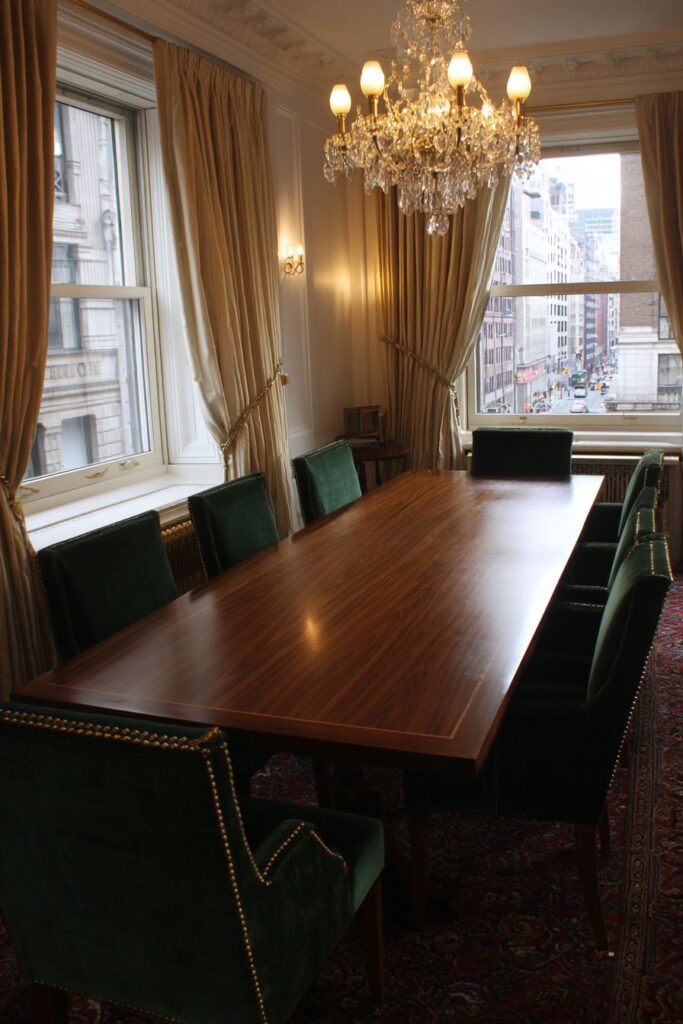
The foundation of this sophisticated dining room lies in its expertly chosen mahogany dining table, where subtle wood grain details tell the story of careful craftsmanship and natural beauty. The rich, chocolate-brown tones of the mahogany create a sense of gravitas and permanence that immediately establishes the room’s old money credentials. Surrounding this magnificent centerpiece are upholstered chairs in deep forest green velvet, their luxurious texture enhanced by brass nailhead trim that catches the light and adds subtle metallic accents throughout the space.
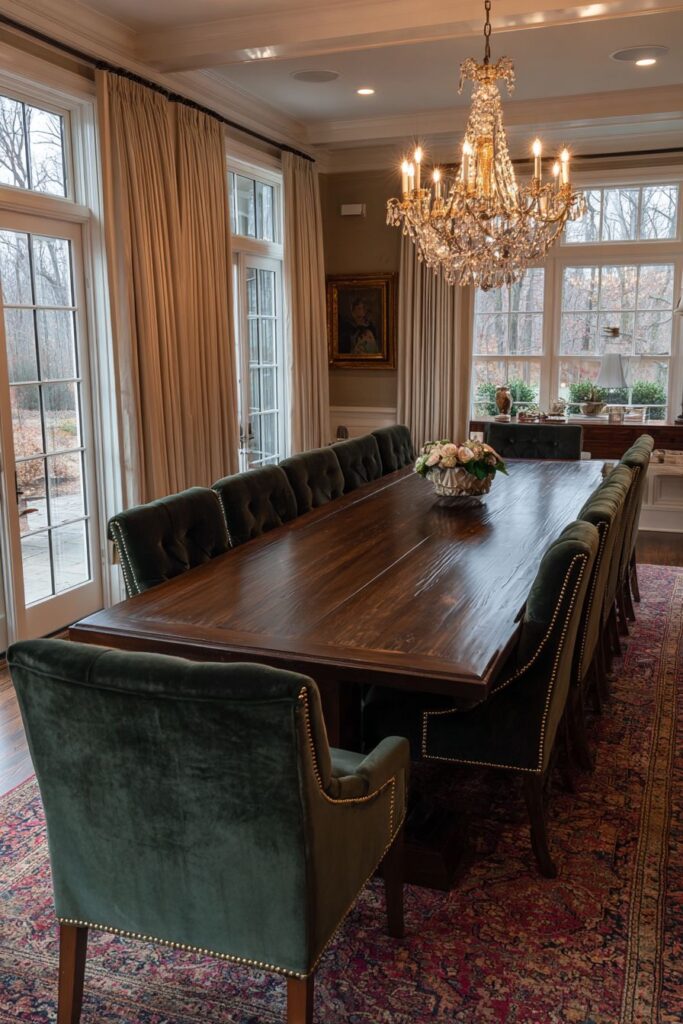
The crystal chandelier suspended above serves as both functional lighting and a stunning focal point, its warm LED bulbs casting a soft, amber glow that enhances the natural warmth of the wood tones. This carefully considered lighting choice avoids the harsh brightness of traditional bulbs, instead creating an intimate atmosphere perfect for long dinner conversations and formal entertaining. The chandelier’s faceted crystal elements create dancing patterns of light across the room’s surfaces, adding movement and sparkle to the sophisticated color palette.
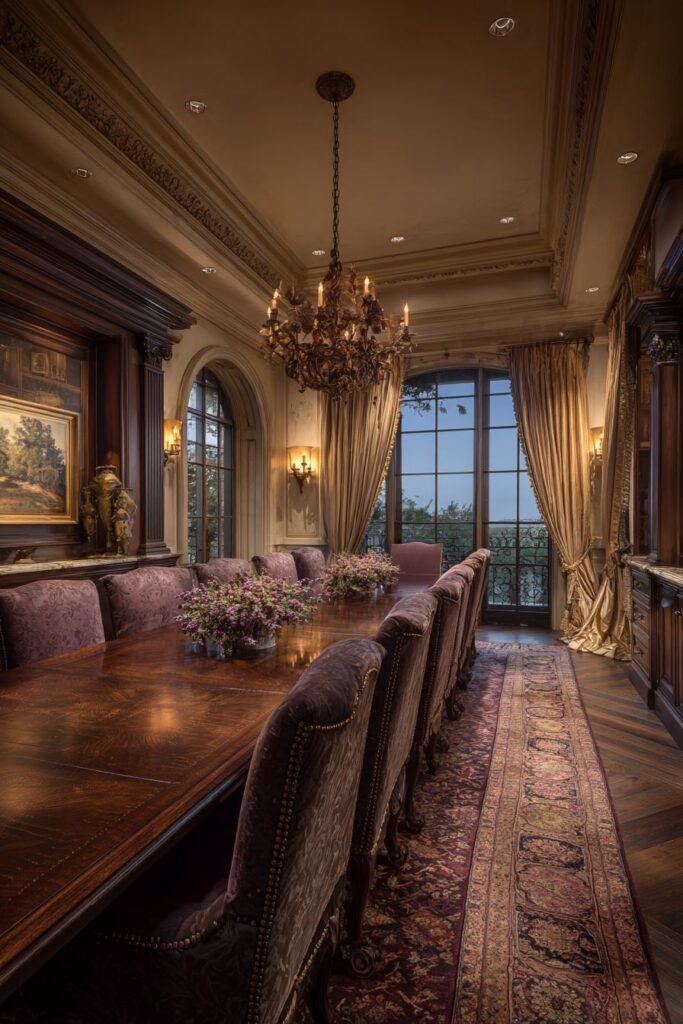
A Persian rug in muted burgundy and gold tones anchors the seating area, its intricate patterns providing visual interest while remaining understated enough not to compete with the furniture’s rich materials. The rug’s deep colors complement both the mahogany table and forest green upholstery, creating a cohesive color story that feels both planned and effortless. Natural light filtering through tall windows dressed in cream silk drapes adds another layer of luxury, with the silk’s subtle sheen catching the light and creating gentle movement as air currents shift the fabric.
The interplay of textures in this space—smooth mahogany, plush velvet, sparkling crystal, and soft silk—creates a sensory richness that defines old money interior design. Each element has been chosen for its quality and longevity rather than its trendiness, ensuring that this dining room will remain beautiful and relevant for decades to come.
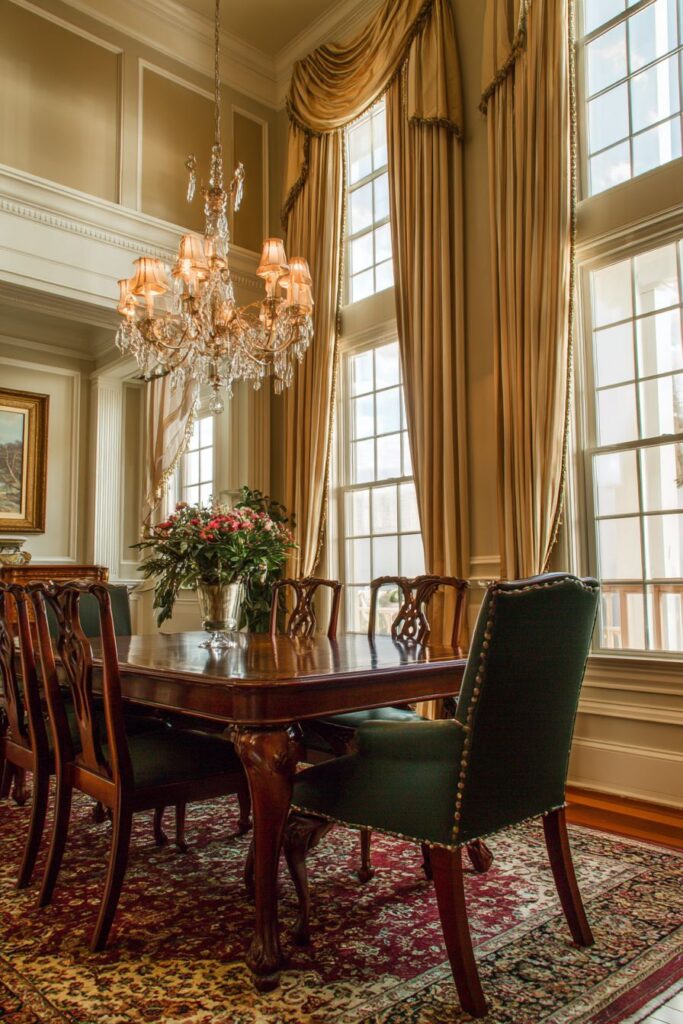
Key Design Tips:
- Choose mahogany furniture with visible grain patterns for authentic character
- Incorporate brass accents through nailhead trim and hardware for warmth
- Layer lighting with both ambient chandelier and natural window light
- Select Persian rugs with muted, traditional color palettes that complement wood tones
- Use cream or ivory silk window treatments to soften harsh architectural lines
2. Formal Table Setting Mastery
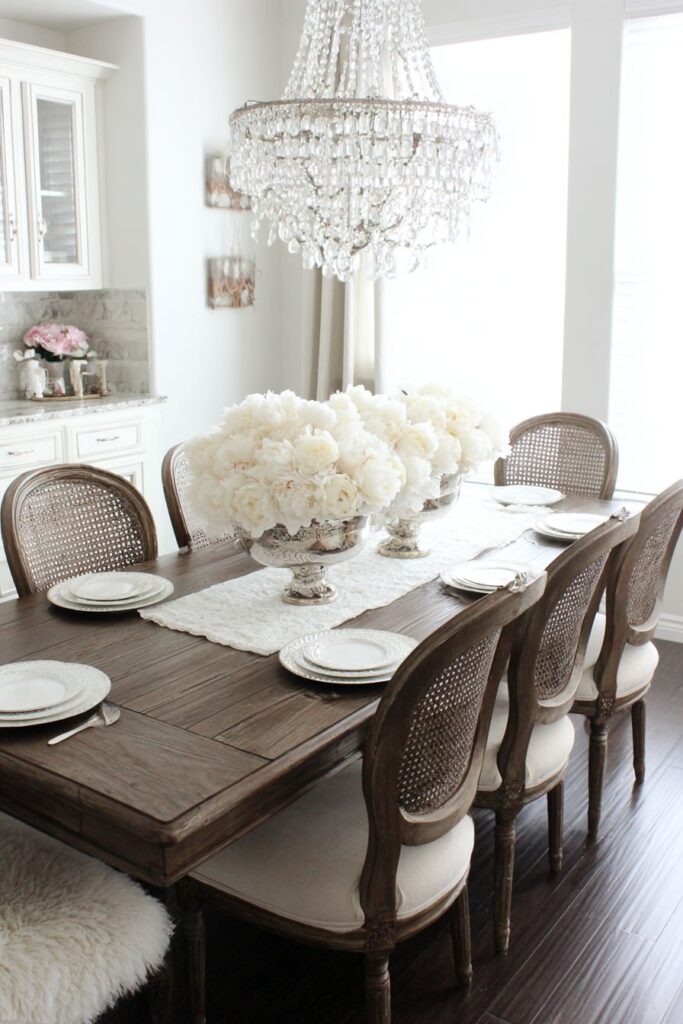
The art of formal table setting reaches its pinnacle in this refined dining room, where every element has been carefully chosen and precisely placed to create an atmosphere of understated luxury. Fine bone china plates, their pristine white surfaces adorned with subtle rim details, serve as the foundation for each place setting, their quality immediately apparent in their translucent beauty and delicate weight. Sterling silver flatware, properly arranged according to traditional etiquette rules, gleams against crisp white linen, each piece reflecting the room’s ambient lighting and adding sparkle to the table’s surface.
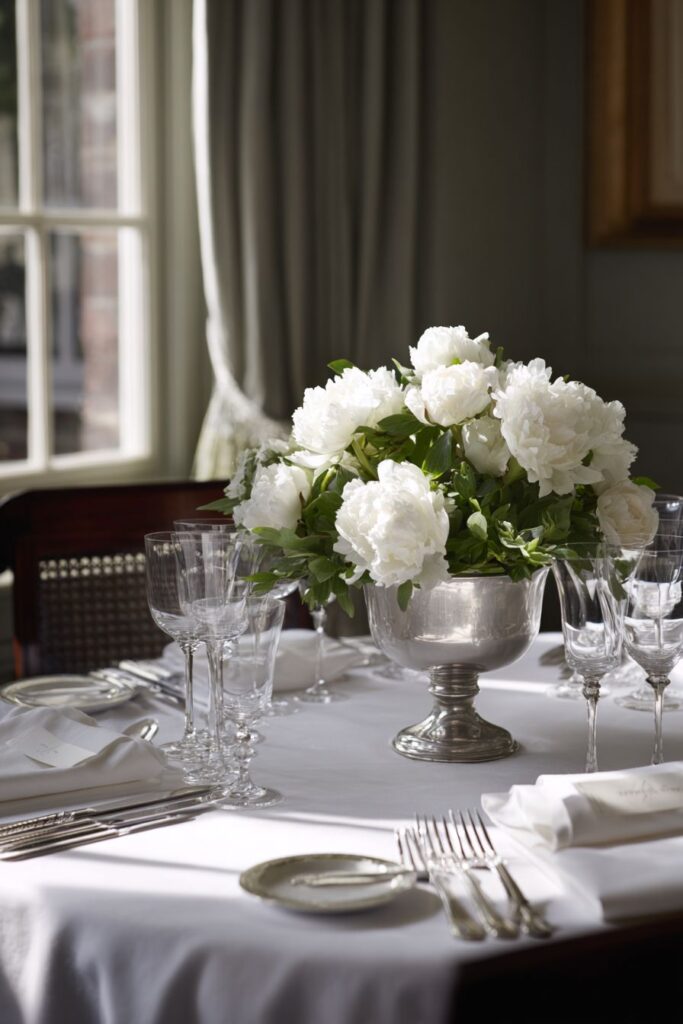
Crystal stemware stands ready to catch and refract light, their clear brilliance creating prisms of color that dance across the white linen tablecloth. The choice of white linen is deliberate—its neutral backdrop allows the silver and crystal to take center stage while maintaining the clean, classic aesthetic that defines old money style. The linen’s crisp texture and perfect pressing speak to attention to detail and the kind of household standards that have been maintained for generations.
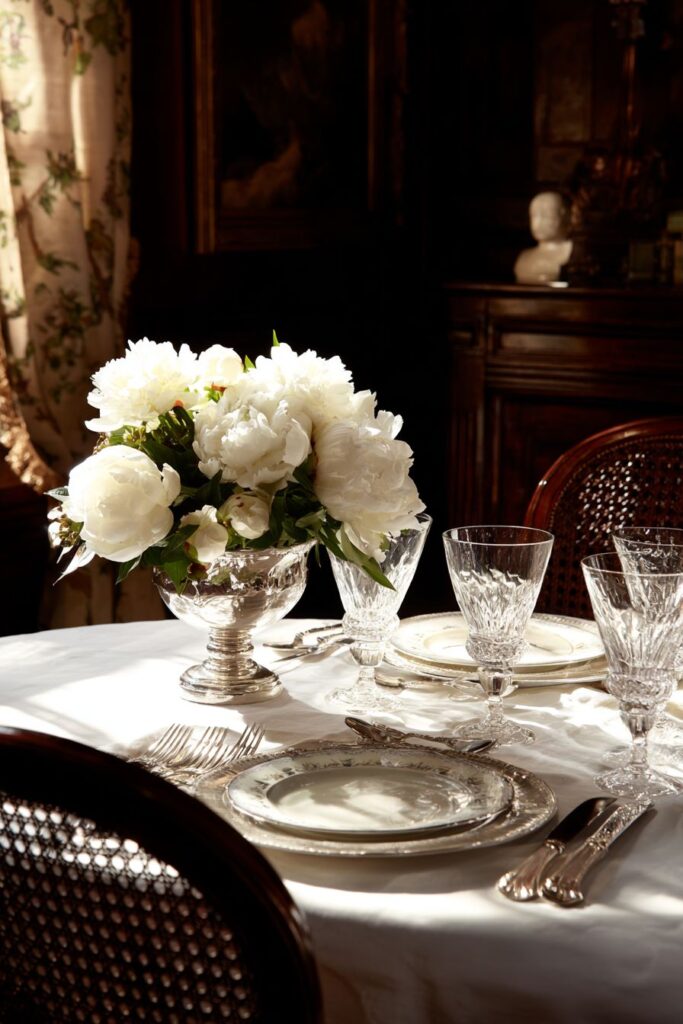
Fresh white peonies arranged in a silver centerpiece bowl provide the perfect finishing touch, their soft, ruffled petals adding organic beauty without overwhelming the table’s formal presentation. The choice of white flowers maintains the refined color palette while bringing life and freshness to the setting. The silver bowl itself becomes part of the room’s metallic accent strategy, coordinating with the flatware and adding another layer of reflected light to the overall composition.
Dark walnut dining chairs with traditional cane backing surround the polished wood table, their classic proportions and time-honored construction methods representing the kind of quality craftsmanship that improves with age. The cane backing adds textural interest while remaining neutral enough not to compete with the table’s formal presentation. Soft natural lighting from nearby windows creates gentle shadows that emphasize the quality of materials and the careful attention to detail that characterizes this approach to formal dining.
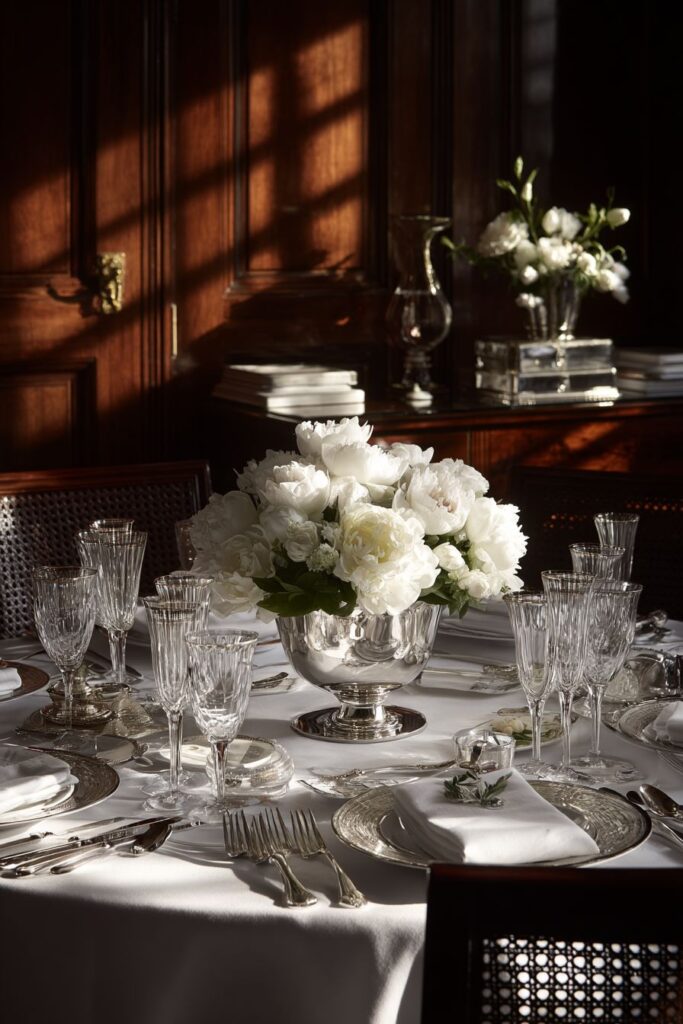
Key Design Tips:
- Invest in genuine bone china for its translucent quality and durability
- Choose sterling silver flatware that will develop beautiful patina over time
- Use crisp white linen as a neutral backdrop for formal presentations
- Select fresh flowers in monochromatic arrangements for sophisticated simplicity
- Position chairs with classic proportions that complement rather than compete with table settings
3. Heirloom Display and Built-in Storage

The built-in china cabinet in this dining room represents the perfect marriage of functionality and display, showcasing generations of collected treasures behind glass doors with traditional mullioned detailing. The cabinet’s rich cherry wood construction demonstrates the kind of quality craftsmanship that characterizes old money furnishing choices—solid wood construction with traditional joinery methods that will last for generations. Traditional crown molding adds architectural interest and creates a finished, custom appearance that integrates seamlessly with the room’s overall design scheme.
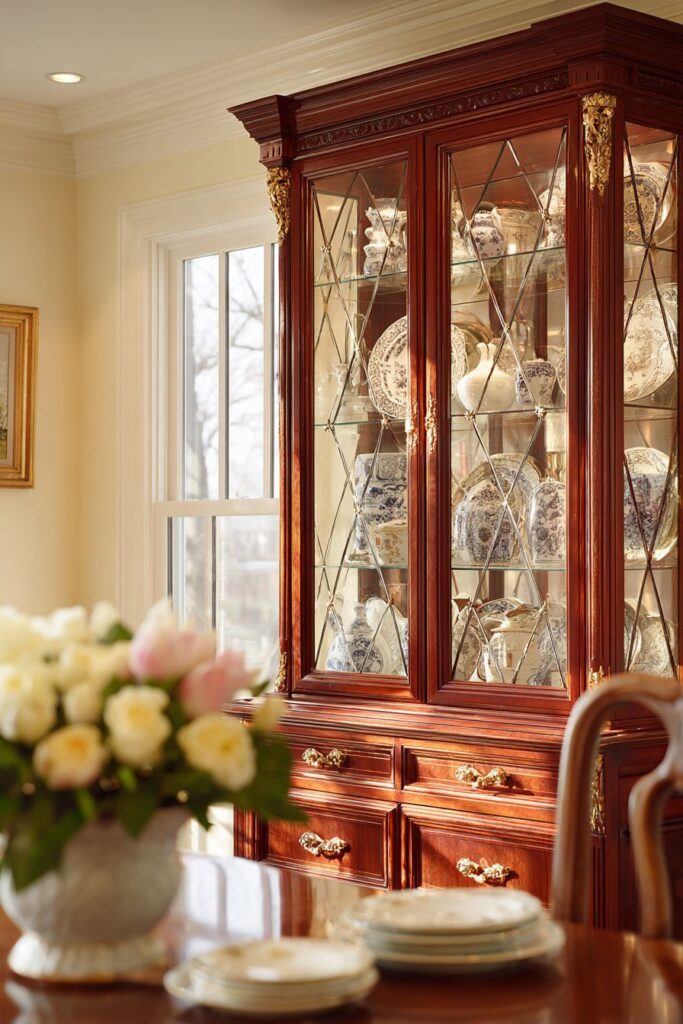
Behind the glass doors, heirloom porcelain and crystal collections are artfully arranged to create visual interest while protecting valuable pieces from dust and damage. The organization of these pieces tells a story of family history and careful curation, with each item chosen for both its beauty and its significance. Subtle interior cabinet lighting illuminates the displayed pieces, creating a museum-quality presentation that allows the intricate details of fine china patterns and crystal cutting to be appreciated even when not in use.
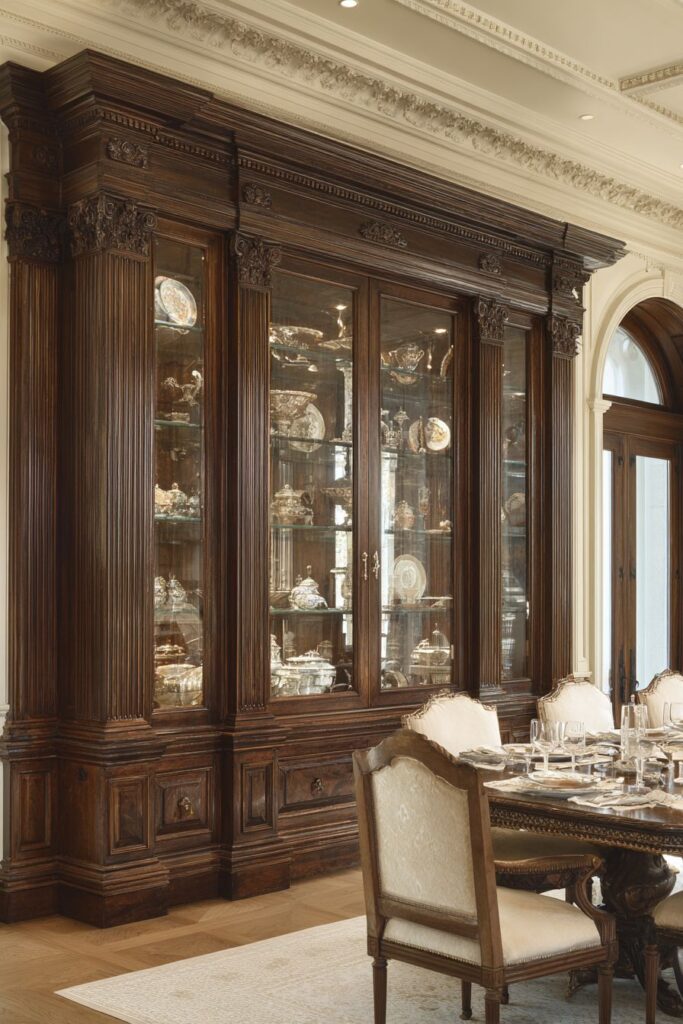
The adjacent dining area continues the rich wood theme with coordinating furniture pieces that share the same quality construction and brass hardware accents. This consistency in material choices and finish quality creates a cohesive environment where each piece complements the others without appearing to be part of a matching set. The brass hardware provides warm metallic accents that coordinate with other brass elements throughout the room, creating a subtle thread that ties the design together.
Professional interior photography reveals how balanced exposure showcases both the craftsmanship details in the woodwork and the warm wood tones against cream wall paint. This neutral wall color allows the rich wood tones to take center stage while providing enough contrast to define architectural details and furniture silhouettes. The overall effect is one of curated elegance where functional storage solutions become part of the room’s decorative strategy.
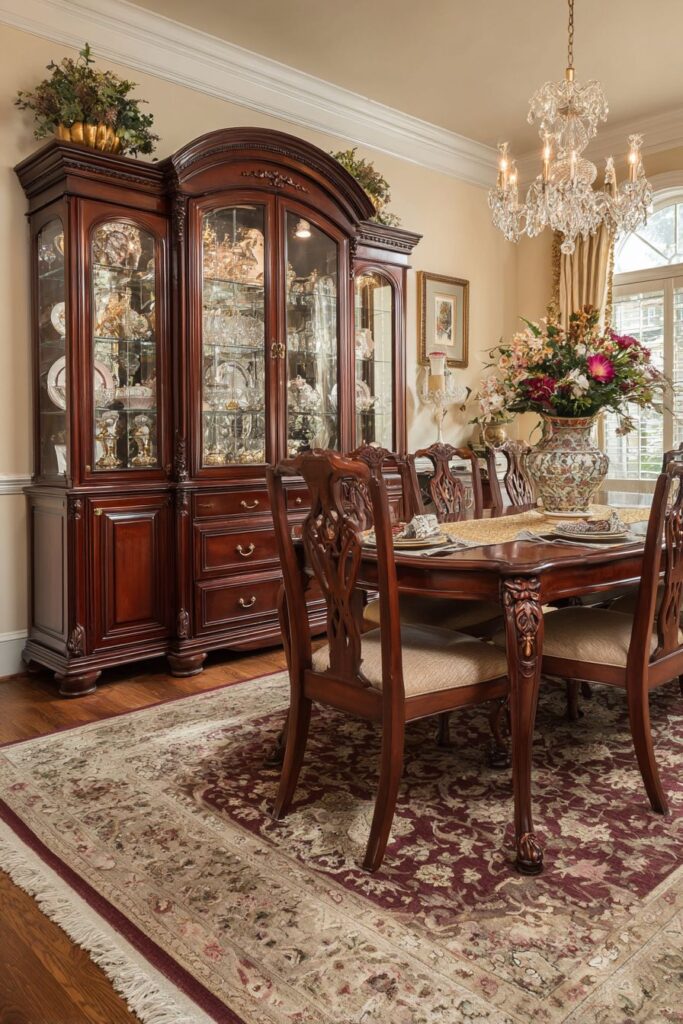
Key Design Tips:
- Choose built-in cabinetry with solid wood construction for longevity
- Install interior cabinet lighting to showcase displayed collections
- Use traditional millwork details like crown molding for finished appearance
- Coordinate brass hardware throughout the space for metallic consistency
- Paint walls in neutral tones that complement rather than compete with wood furniture
4. Wingback Elegance with Traditional Architecture
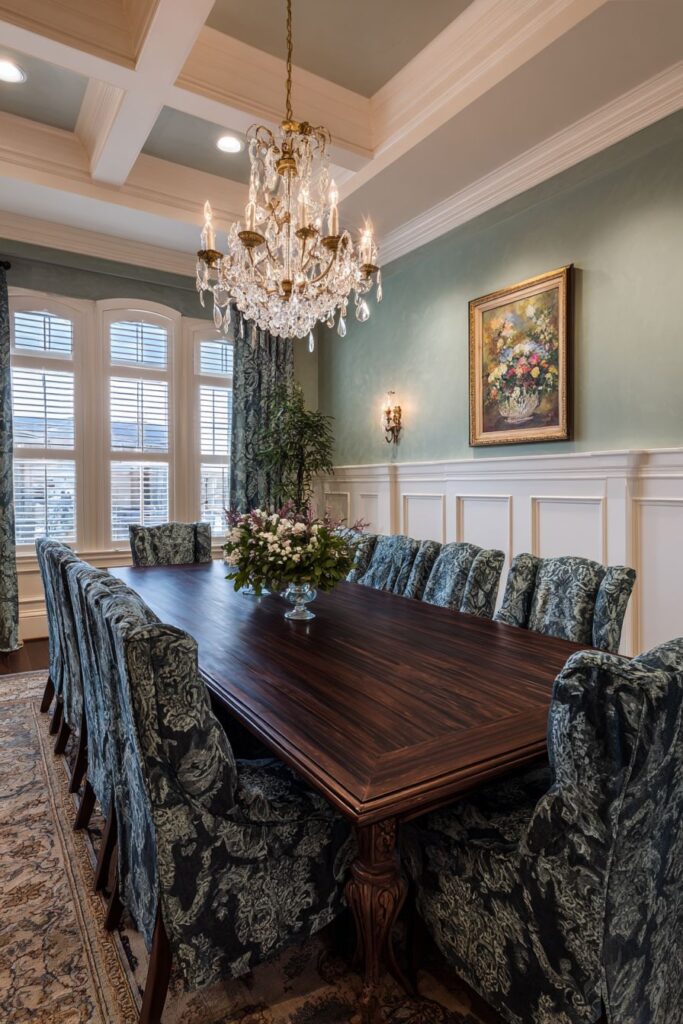
The rectangular dining table in deep walnut with its hand-carved pedestal base serves as the magnificent centerpiece of this traditionally appointed dining room, its substantial presence commanding attention while demonstrating the kind of craftsmanship that improves with age. The hand-carved details in the pedestal base reveal the artisan’s skill and add visual interest at the table’s foundation, creating a focal point that draws the eye and establishes the room’s commitment to quality over convenience.
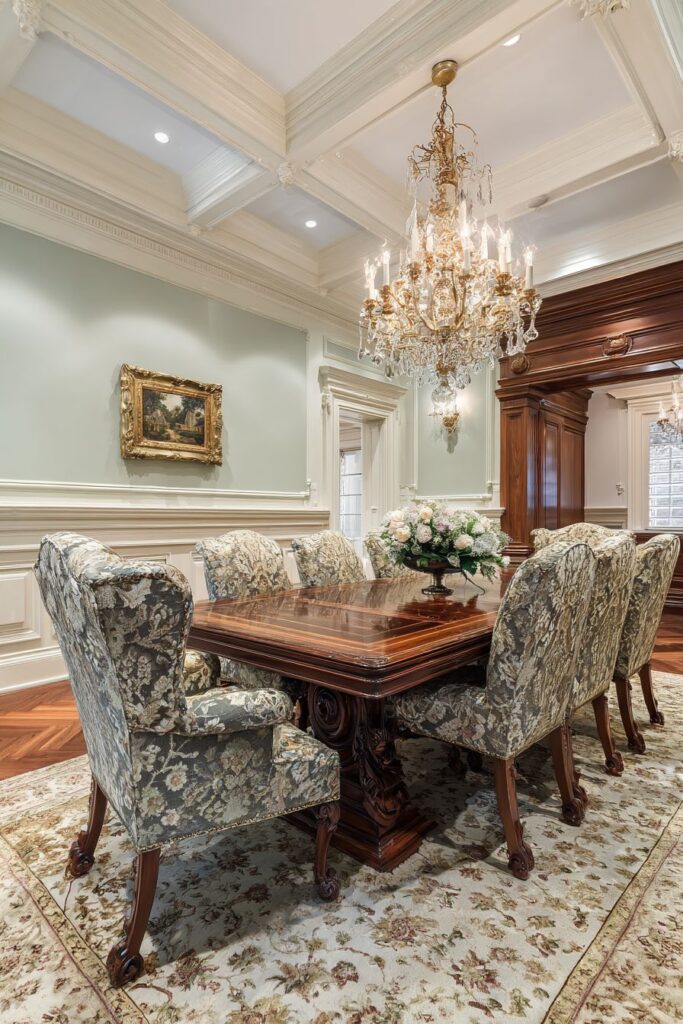
Surrounding this impressive table, wingback chairs upholstered in navy blue damask fabric provide both comfort and visual sophistication. The wingback silhouette is a classic choice that never goes out of style, offering both physical comfort and the kind of formal presence appropriate for a serious dining room. The navy blue damask fabric adds pattern and texture while remaining subtle enough to work with changing table settings and seasonal decorations. The damask pattern itself speaks to traditional textile choices that have been favored by discerning homeowners for centuries.
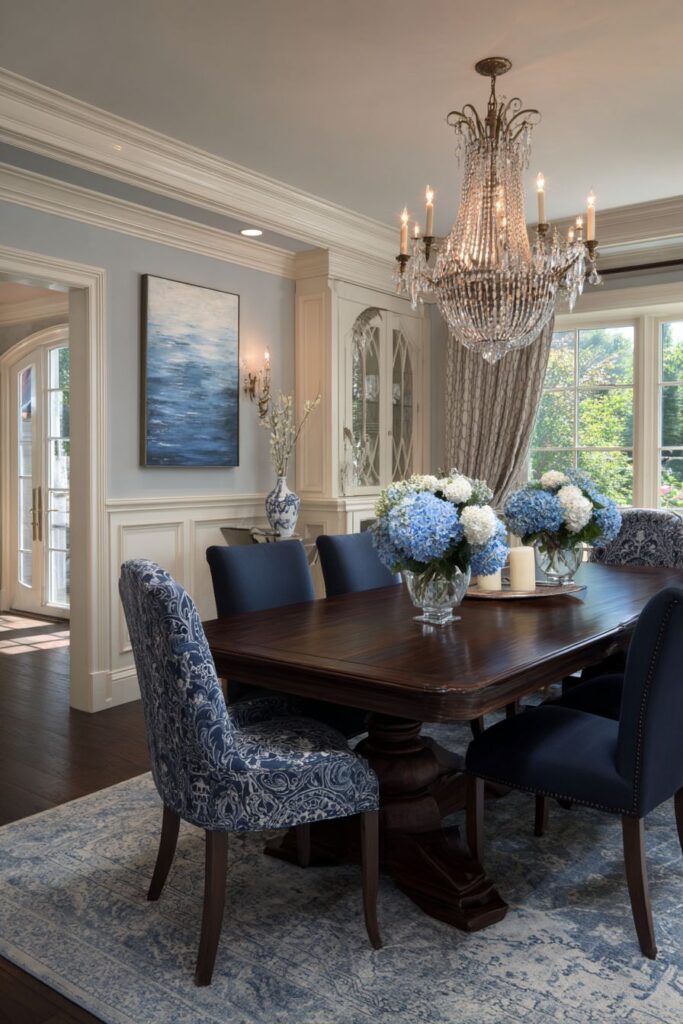
A traditional brass and crystal chandelier provides elegant overhead lighting, its warm metallic finish coordinating with other brass accents throughout the room while its crystal elements add sparkle and light refraction. The chandelier’s proportions are carefully chosen to complement the table size and room dimensions, creating balanced lighting that enhances rather than overwhelms the space’s other elements.
Cream wainscoting with chair rail molding adds significant architectural interest to sage green walls, creating the kind of layered, sophisticated wall treatment that characterizes old money interiors. The wainscoting provides visual weight and texture at the room’s lower level, while the sage green paint color above the chair rail adds subtle color that complements the navy upholstery and walnut wood tones. This traditional approach to wall treatment creates depth and interest while maintaining the refined color palette that defines the space.
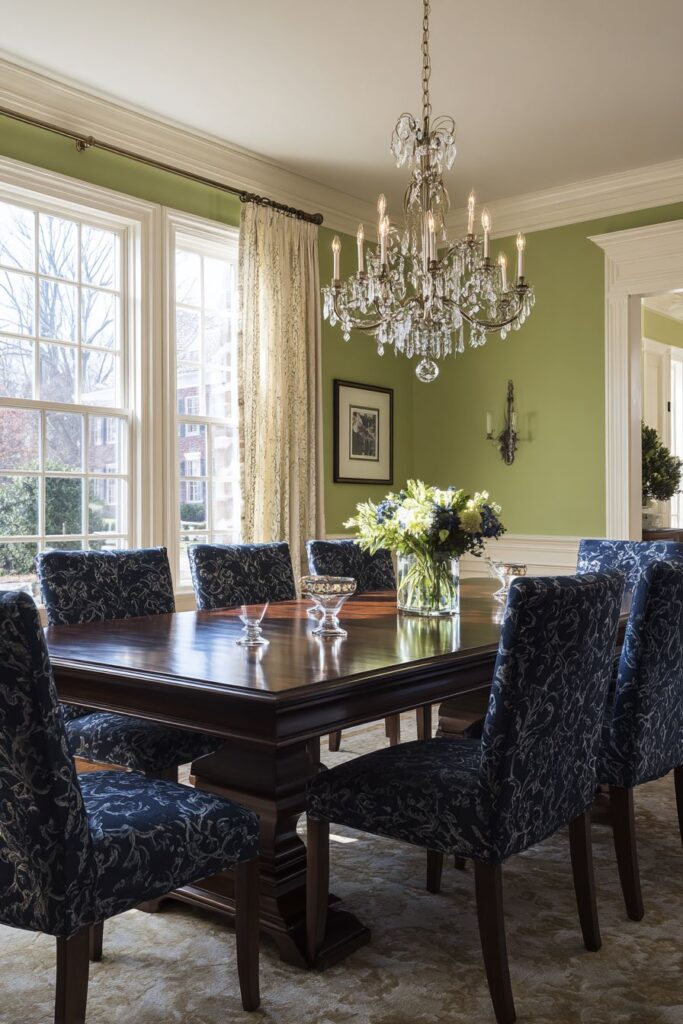
Key Design Tips:
- Select dining tables with hand-carved details that showcase artisan craftsmanship
- Choose wingback chairs for their timeless silhouette and formal presence
- Incorporate damask fabrics for traditional pattern that works with various color schemes
- Add architectural interest through wainscoting and molding details
- Use sage green paint colors for sophisticated wall treatments that complement wood tones
5. Antique Sideboard and Fine Art Integration
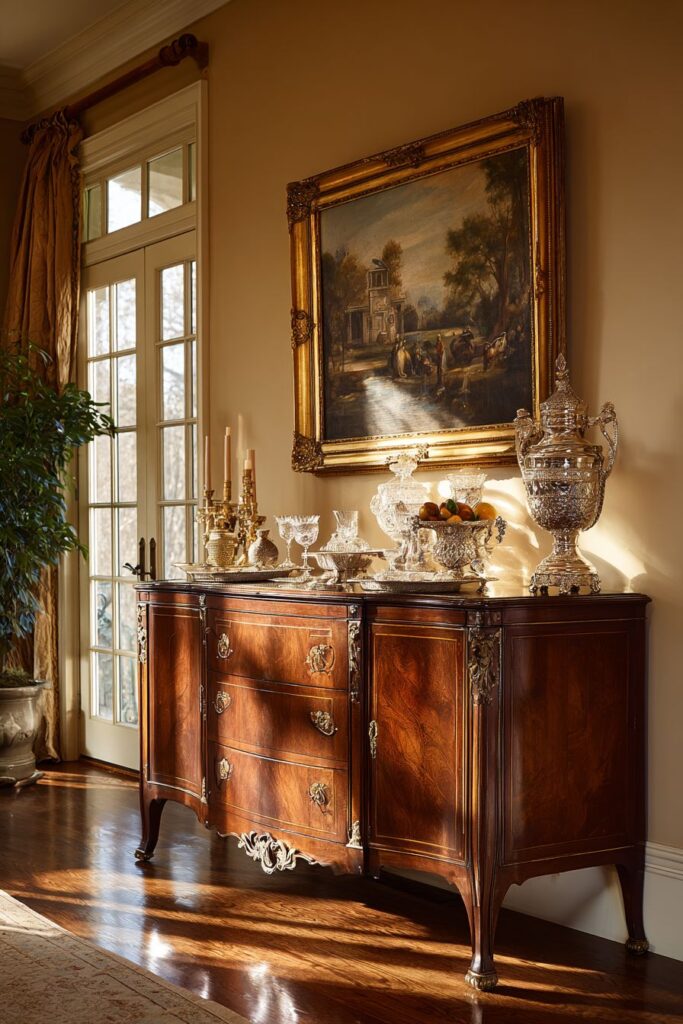
The antique sideboard in rich mahogany becomes a functional work of art in this sophisticated dining room, its generous surface providing the perfect platform for displaying silver serving pieces and crystal decanters with artistic precision. The mahogany’s deep, lustrous finish speaks to decades of careful maintenance and the kind of quality construction that allows furniture to improve with age. Each silver serving piece has been chosen not only for its functional value but also for its contribution to the overall aesthetic, creating a curated collection that reflects both practical entertaining needs and artistic sensibility.
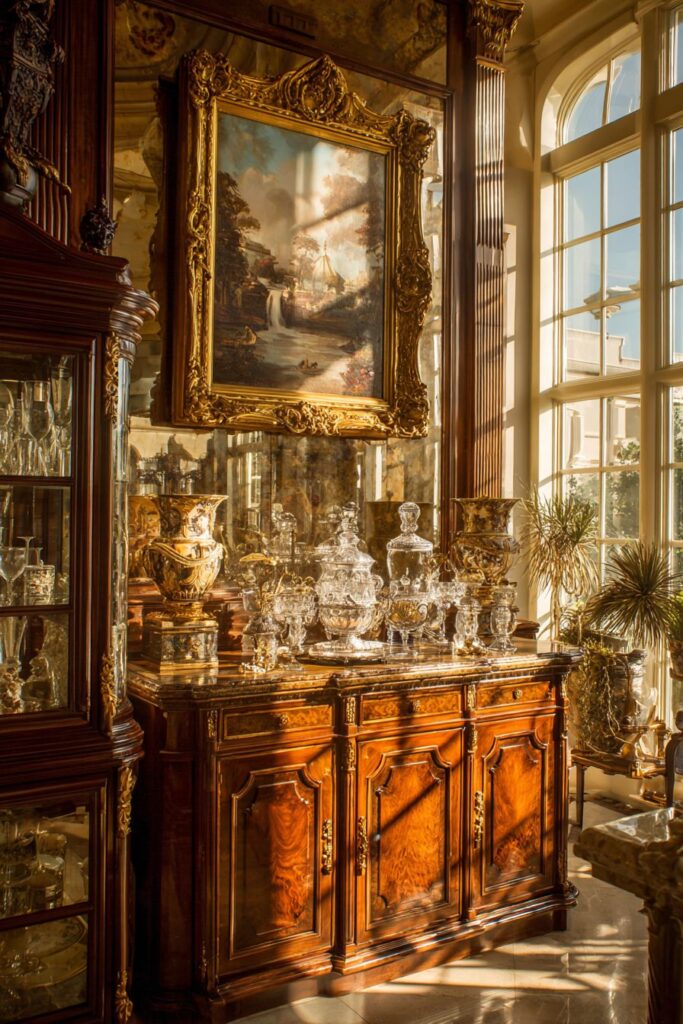
Crystal decanters catch and refract the room’s ambient lighting, their faceted surfaces creating prismatic effects that add movement and sparkle to the sideboard’s display. The arrangement of these pieces follows traditional principles of symmetry and balance, with taller items providing vertical interest while smaller pieces fill in the composition without creating clutter. This careful curation demonstrates the old money principle of having fewer, better things rather than filling space with unnecessary objects.
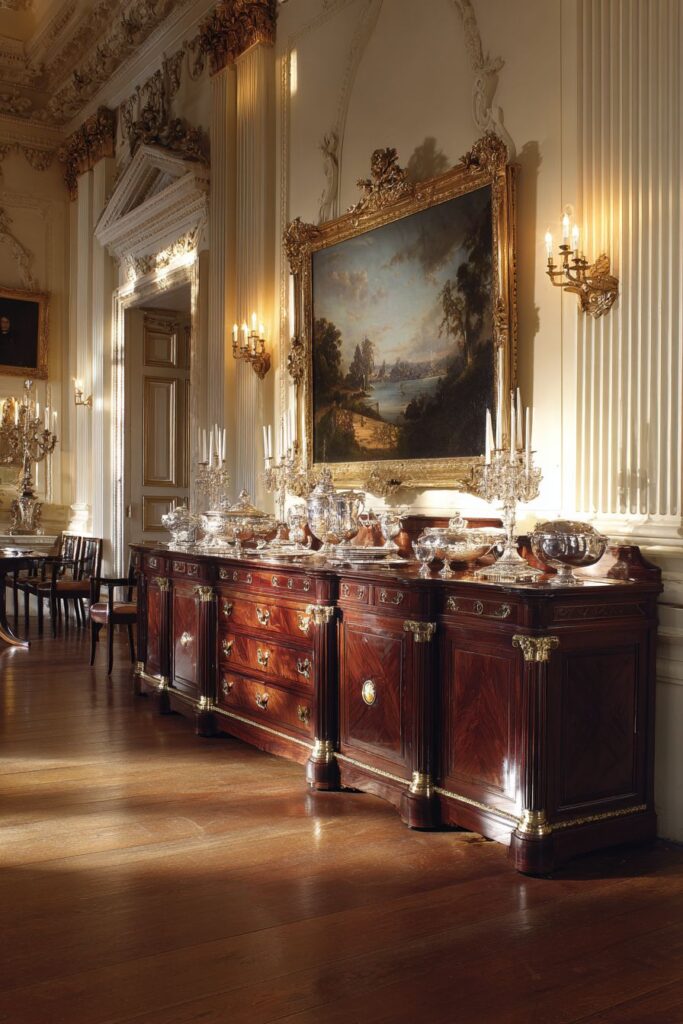
Above the sideboard, an oil painting in an ornate gilded frame depicting a classical landscape provides a sophisticated focal point that elevates the entire vignette. The choice of classical subject matter reflects the old money preference for timeless themes over contemporary or trendy artwork. The gilded frame coordinates with the brass accents found throughout the room while adding another layer of metallic richness that enhances the overall luxury quotient.
The surrounding space continues the traditional theme with coordinating furniture pieces that share the same commitment to quality materials and brass accent details. Soft natural lighting from tall windows creates warm reflections on polished surfaces, enhancing the interplay of materials and adding depth to the room’s sophisticated color palette. The natural light also brings out the subtle variations in the mahogany grain and highlights the intricate details of the silver serving pieces.
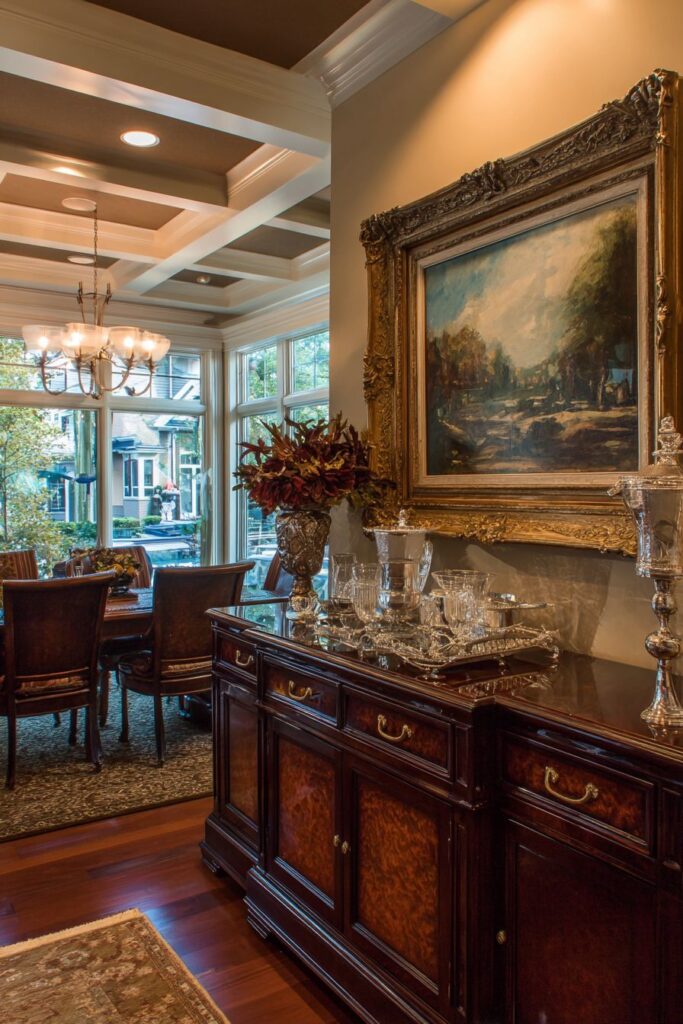
Key Design Tips:
- Arrange sideboard displays with attention to height, balance, and visual weight
- Choose crystal decanters for both function and their light-refracting properties
- Select classical artwork subjects for timeless appeal
- Coordinate frame finishes with other metallic accents throughout the room
- Position sideboards to take advantage of natural light for surface reflections
6. Sophisticated Window Treatment Design

The elegant window treatments in this dining room demonstrate how the right fabric choices and hardware selections can transform simple windows into sophisticated architectural features. Ivory silk panels with subtle damask patterns provide the perfect balance of privacy and light filtration while adding luxury through their material quality and craftsmanship details. The silk’s natural sheen catches and reflects the room’s light sources, creating gentle movement and visual interest as the fabric responds to air currents and changing light conditions.
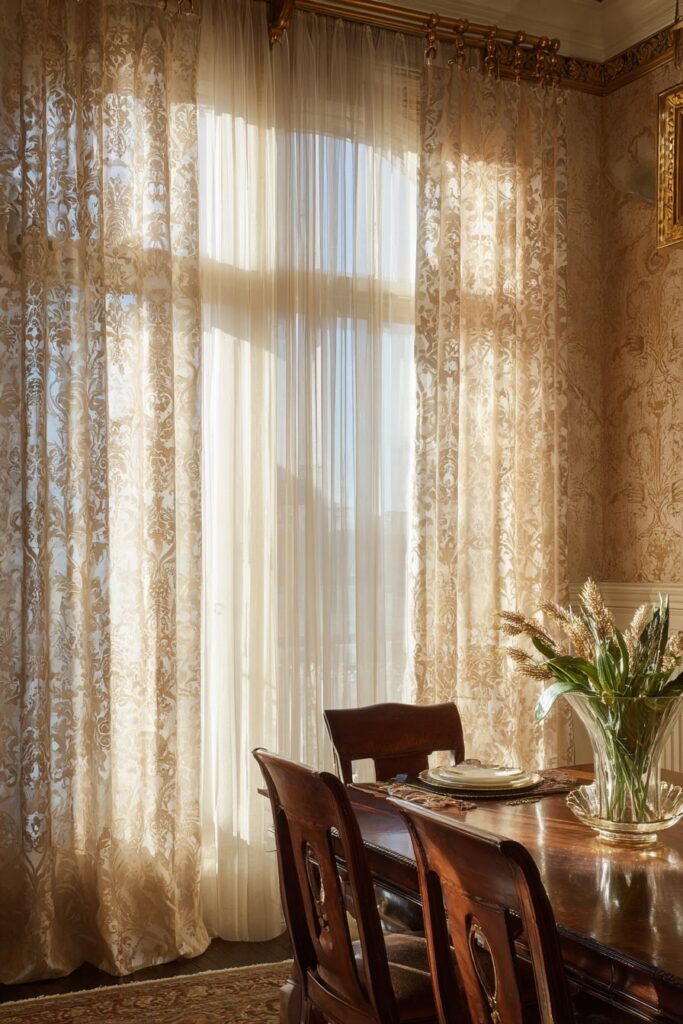
The brass rods with decorative finials serve as both functional hardware and decorative elements, their warm metallic finish coordinating with other brass accents throughout the room while adding architectural detail at the window’s crown. The finials themselves become sculptural elements that cap the window treatment with appropriate flourish, demonstrating attention to detail that extends to every aspect of the room’s design.

Layered window coverings include sheer panels behind the silk damask, providing privacy options while maintaining light flow throughout the day. This layering approach allows for flexible light control while ensuring that the windows never appear stark or unfinished. The sheers also add another textural element that enhances the overall sophistication of the window treatment without competing with the primary silk panels.
Natural light filtering through these carefully chosen treatments creates a warm ambiance that enhances the traditional dining setup with quality wood furniture. The filtered light takes on a golden quality as it passes through the silk, creating a flattering illumination that enhances skin tones and makes food appear more appetizing. This attention to how lighting affects the dining experience demonstrates the thoughtful approach that characterizes old money interior design.
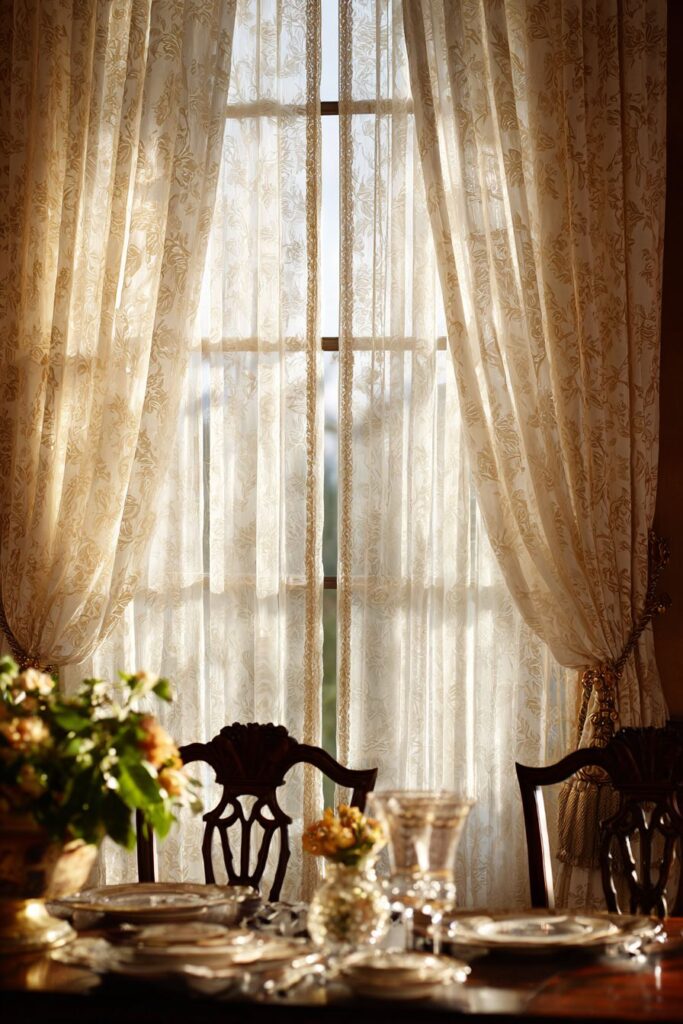
Key Design Tips:
- Choose silk fabrics for their natural sheen and luxury appeal
- Layer window treatments for flexible privacy and light control
- Select brass hardware that coordinates with other metallic accents
- Consider how filtered light affects the room’s ambiance and color temperature
- Use decorative finials to add sculptural interest to window treatments
7. Colonial Influences and Natural Materials
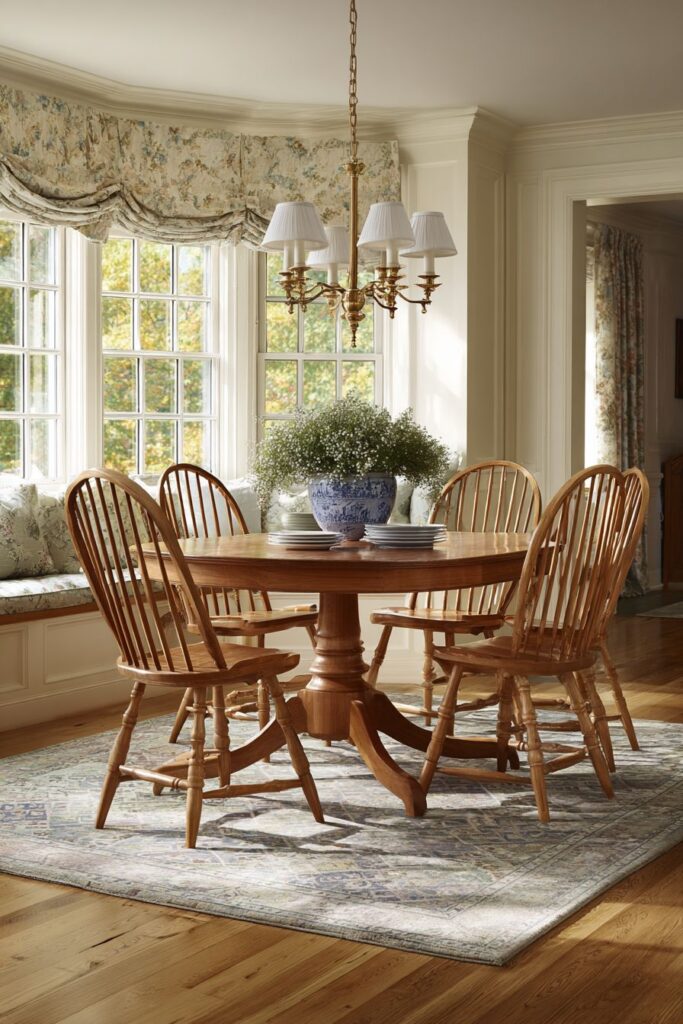
The round pedestal dining table in polished cherry wood serves as the warm centerpiece of this dining room that celebrates American colonial design influences with authentic period details and natural material choices. The cherry wood’s rich reddish-brown tones develop deeper character over time, representing the kind of furniture investment that improves with age and use. The pedestal base design maximizes seating flexibility while showcasing the wood’s natural beauty through its turned details and smooth finish.
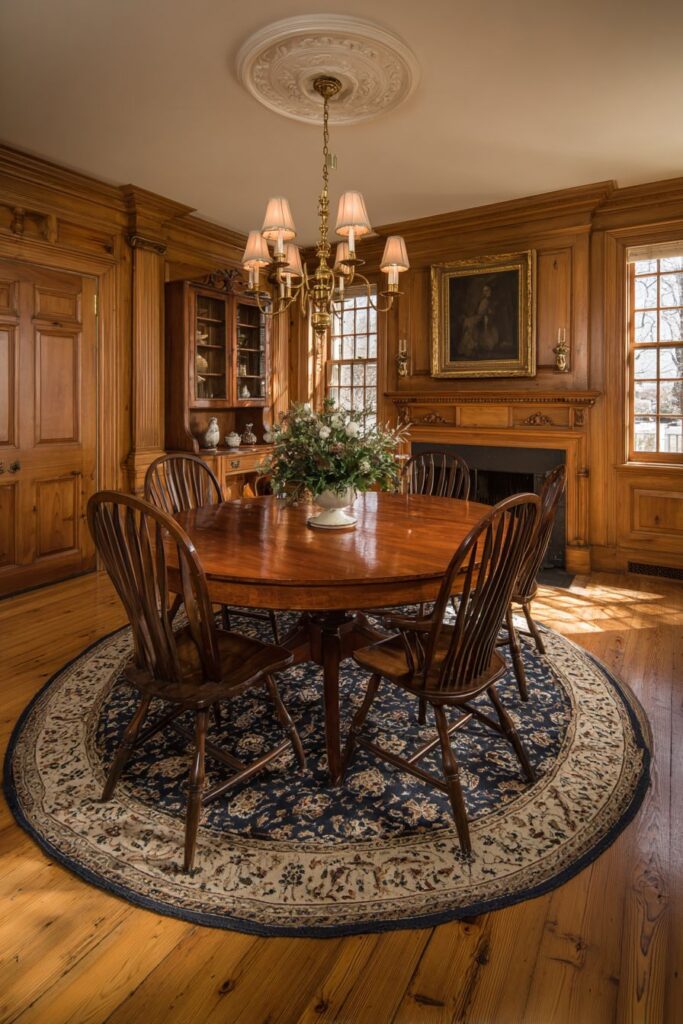
Surrounding the table, ladder-back chairs with rush seats in the traditional Windsor style provide comfortable seating that honors historical design principles while remaining thoroughly practical for modern use. The ladder-back design creates visual lightness that prevents the dining area from feeling heavy or overpowering, while the rush seats add natural texture and demonstrate traditional craftsmanship techniques that connect the present with the past. These chairs represent the kind of honest, functional design that characterizes the best of American colonial furniture.
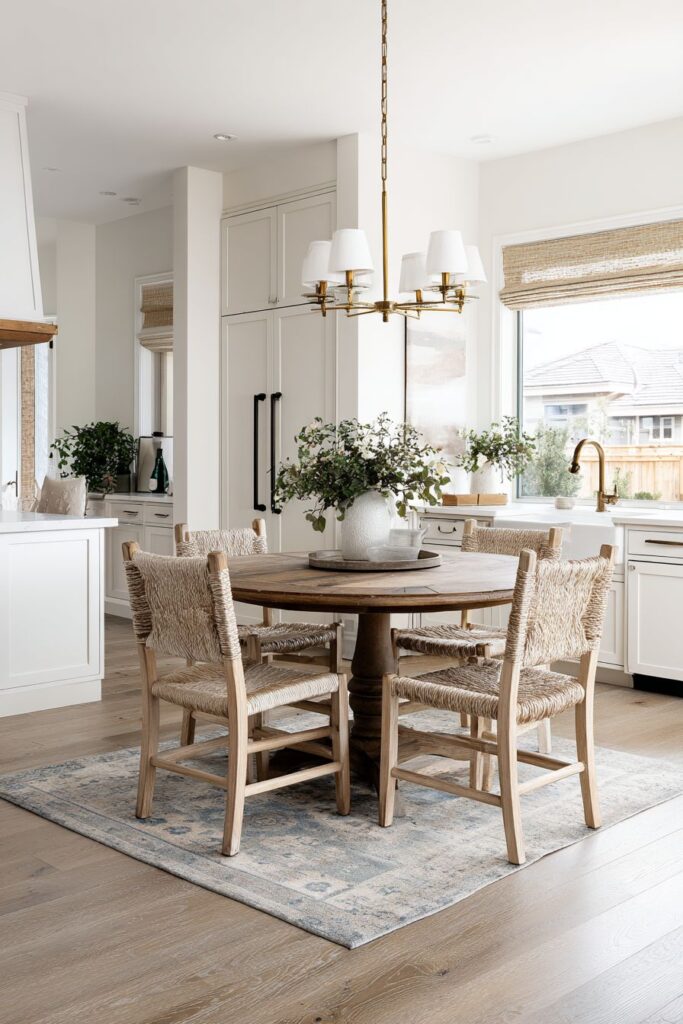
A simple but elegant brass chandelier with white fabric shades provides warm lighting that enhances the natural wood tones without competing with the furniture’s simple beauty. The white fabric shades diffuse the light to create a soft, even illumination that flatters both the diners and the food, while the brass finish adds warmth without excessive ornamentation. This restrained approach to lighting reflects the colonial preference for functional beauty over decorative excess.
Hardwood floors in honey oak with subtle wear patterns show beneath a traditional geometric area rug in muted blues and creams, creating a foundation that celebrates the beauty of natural materials with honest aging. The floor’s subtle wear patterns tell stories of family life and daily use, while the geometric rug pattern provides visual interest without overwhelming the space’s simple beauty. The blue and cream color palette remains fresh and timeless, working beautifully with the warm wood tones throughout the room.
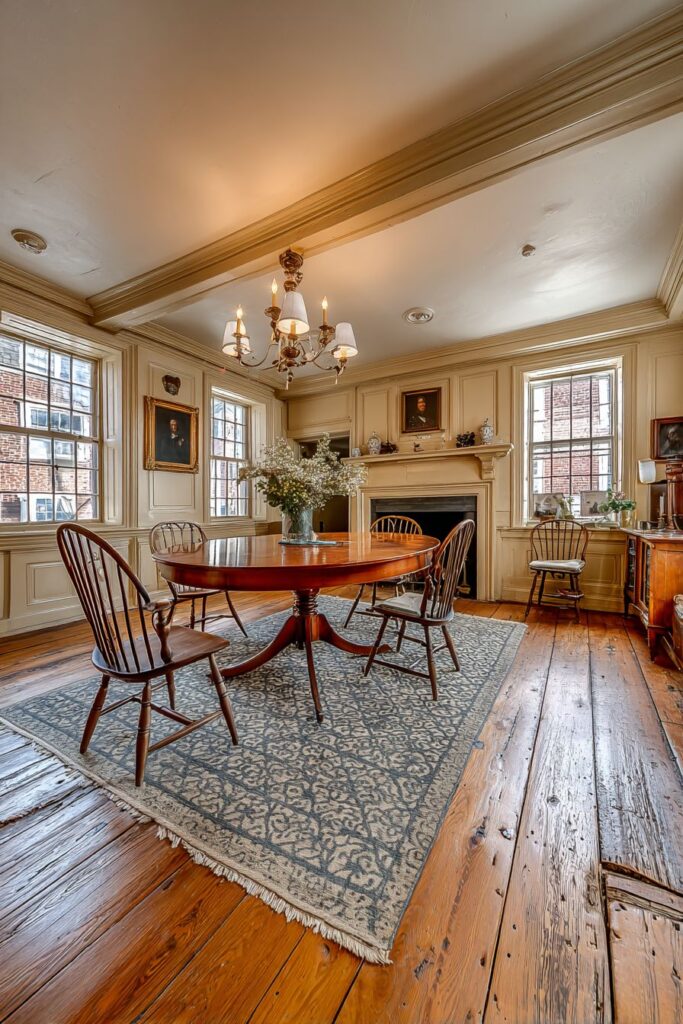
Key Design Tips:
- Choose cherry wood furniture for its aging characteristics and warm tones
- Select chairs with historical design integrity like Windsor ladder-backs
- Use brass lighting fixtures with fabric shades for warm, diffused illumination
- Embrace natural wear patterns in flooring as signs of authentic use
- Select geometric rug patterns in muted colors for timeless appeal
8. Formal Entertaining Excellence

The long rectangular table set for eight represents the pinnacle of formal entertaining, with every detail carefully considered to create an impressive yet welcoming dining experience. The matching high-back chairs upholstered in cream linen with subtle texture provide both comfort and visual sophistication, their neutral color allowing them to work with changing seasonal decorations and table settings while maintaining year-round elegance. The linen upholstery choice demonstrates the old money preference for natural fibers that age beautifully and improve with proper care.
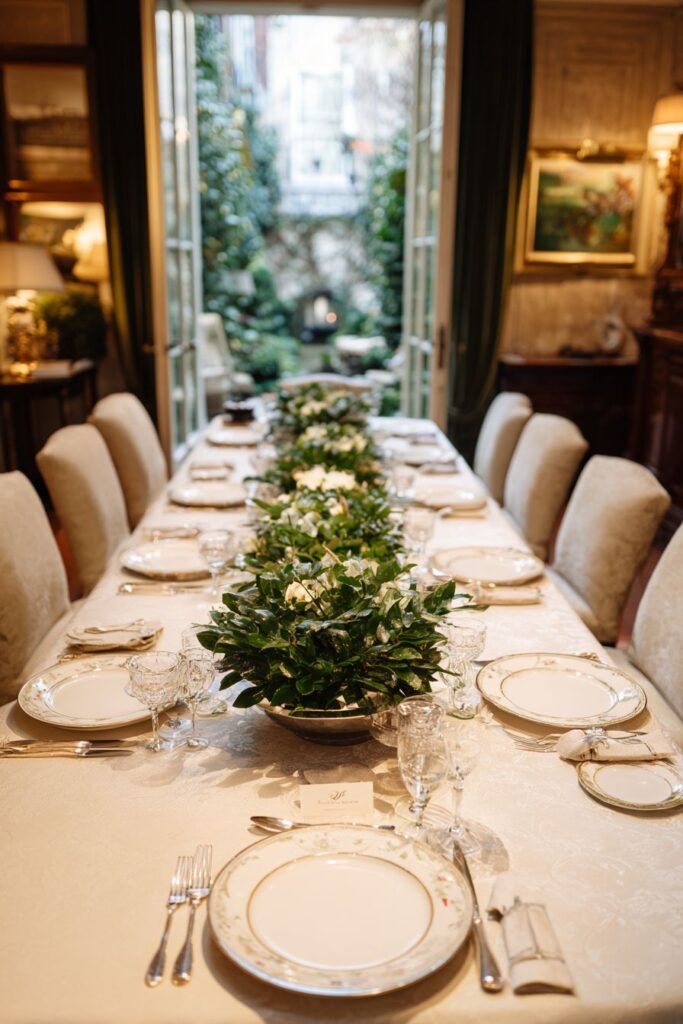
Each place setting showcases attention to detail with white porcelain plates featuring thin gold rim details that add subtle luxury without ostentation. The gold rim provides just enough metallic accent to coordinate with other warm metal elements throughout the room while maintaining the refined simplicity that characterizes sophisticated table settings. Crystal water glasses at each place catch and refract the room’s lighting, adding sparkle and elegance while serving practical purposes.

Silver napkin rings at each place setting represent the kind of traditional table accessories that speak to established entertaining protocols and family traditions. These pieces often carry personal significance, passed down through generations or collected over time, adding layers of meaning to the formal presentation. The silver finish coordinates with serving pieces while adding another opportunity for light reflection and metallic accent.
The fresh greenery centerpiece in a silver bowl runs the length of the table, providing natural beauty that connects the indoor dining experience with the outdoor garden visible through nearby French doors. This connection between interior and exterior spaces reflects the old money appreciation for natural settings and seasonal beauty, while the silver bowl coordinates with other metallic elements throughout the table setting. The low profile of the arrangement ensures that conversation flows easily across the table.
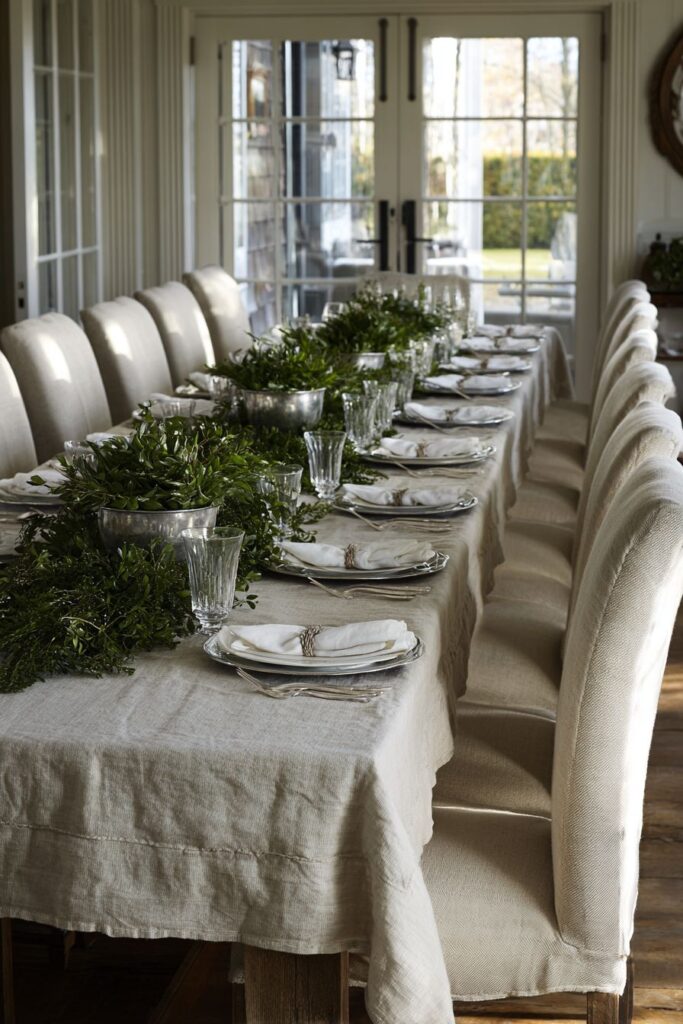
Key Design Tips:
- Set tables with enough place settings to demonstrate entertaining capacity
- Choose porcelain with subtle metallic accents for understated luxury
- Use silver accessories for traditional formal dining protocols
- Create centerpieces that connect interior and exterior environments
- Maintain low centerpiece profiles to encourage conversation
9. Intimate Lighting and Rich Color
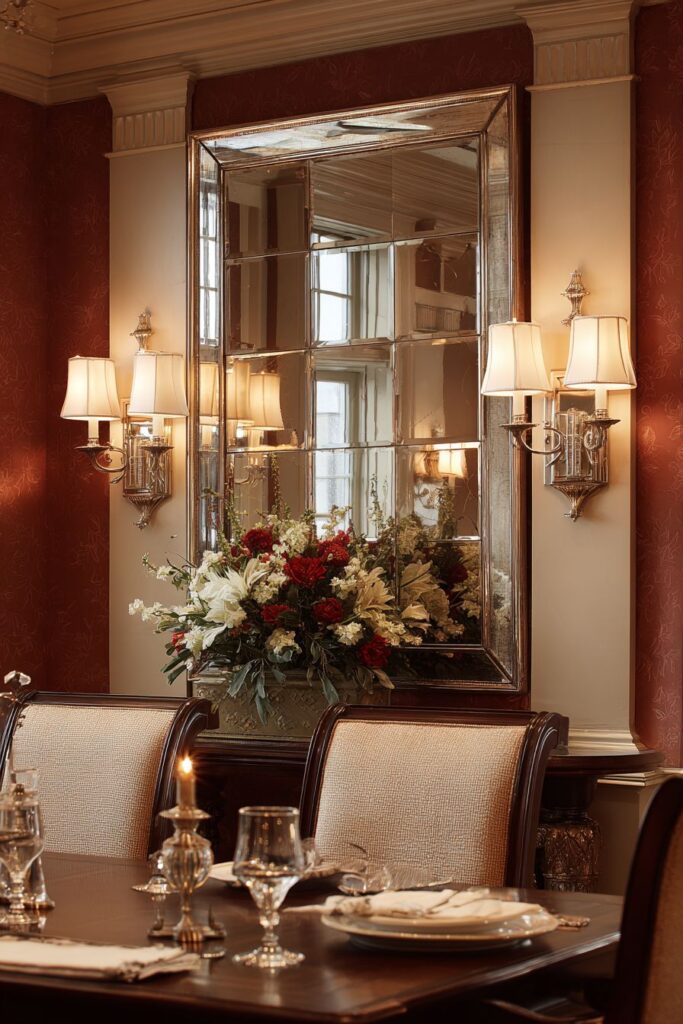
The traditional wall sconces with brass fixtures and white fabric shades create layers of intimate lighting that transform this dining room into a sophisticated evening retreat. The brass fixtures coordinate with other metallic accents throughout the space while providing warm-toned light that flatters both diners and food presentation. The white fabric shades diffuse the light to eliminate harsh shadows while creating a soft, romantic ambiance perfect for intimate dining experiences.

These sconces flank a large mirror with beveled edges in a gold frame, creating a classic symmetrical arrangement that adds both light and visual space to the room. The beveled mirror edges catch and refract light from multiple sources, creating subtle sparkle that enhances the room’s overall luminosity. The gold frame coordinates with the brass sconces while adding another layer of warm metallic accent that contributes to the room’s sophisticated color palette.
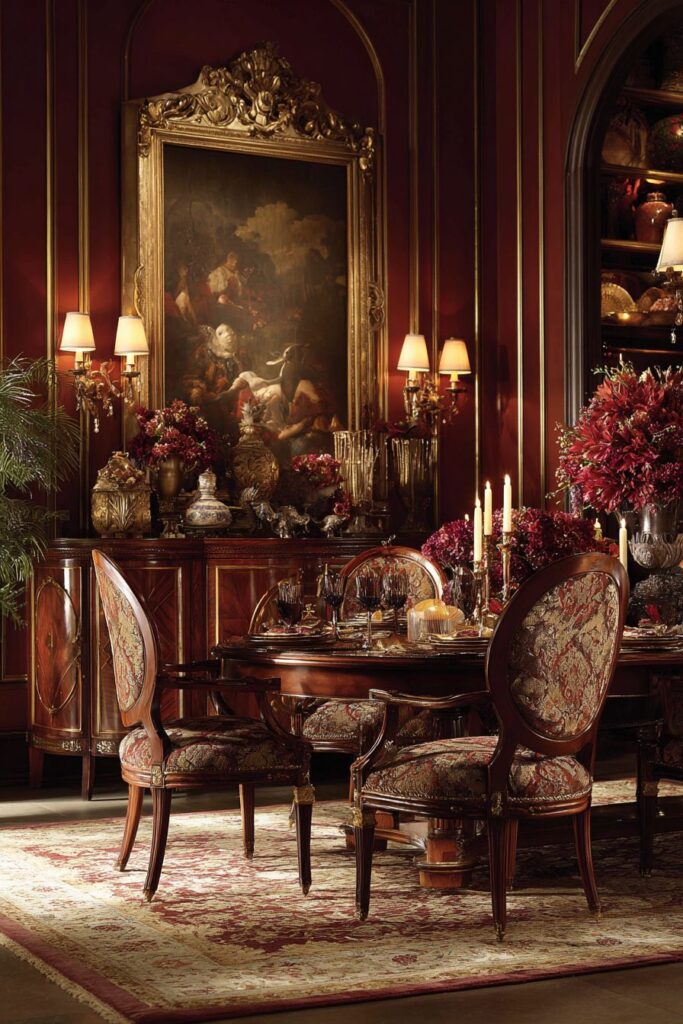
The intimate dining table for four features Queen Anne style chairs that demonstrate the kind of graceful proportions and refined details that characterize quality period furniture. The Queen Anne style’s gentle curves and elegant silhouette provide visual softness that balances the room’s stronger architectural elements while maintaining the formal dignity appropriate for a serious dining space. These chairs represent furniture as art, chosen as much for their aesthetic contribution as their functional value.
Deep burgundy walls provide a rich backdrop that makes the warm metallic accents appear to glow with inner light. This dramatic color choice demonstrates confidence in design decisions and creates a cocoon-like intimacy that makes dining feel special and removed from everyday concerns. The burgundy color works beautifully with brass and gold accents while providing enough depth to make the space feel substantial and important.

Key Design Tips:
- Layer lighting sources for flexible ambiance control
- Use mirrors to multiply light sources and create visual expansion
- Choose period furniture styles with graceful proportions
- Consider dramatic wall colors for intimate dining experiences
- Coordinate metallic finishes throughout lighting and decorative elements
10. Family Heritage and Personal Collections
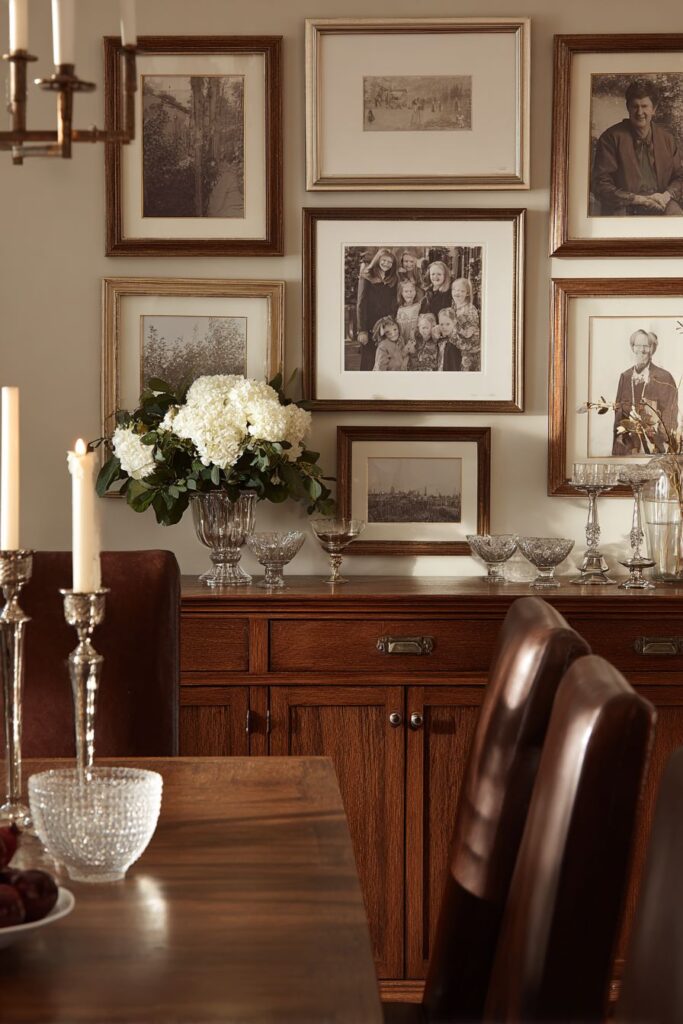
The gallery wall arrangement above the long sideboard creates a sophisticated display that celebrates family history and personal collections with museum-quality presentation. The combination of family portraits and landscape paintings in various sizes creates visual interest while maintaining the kind of personal touch that makes old money interiors feel lived-in rather than designed. The coordinating gold and wood frames create unity within variety, demonstrating how thoughtful curation can make diverse pieces work together harmoniously.
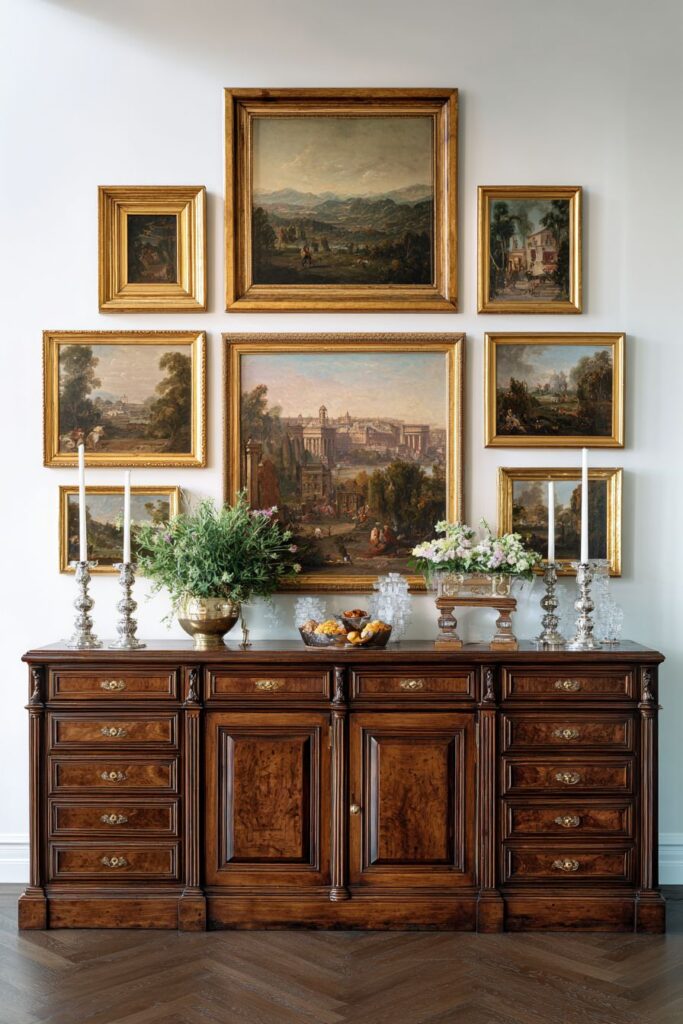
The careful arrangement of different frame sizes follows traditional gallery wall principles, with larger pieces anchoring the composition while smaller works fill in the visual spaces without creating clutter. This approach to art display demonstrates the kind of confident design sensibility that comes from understanding both artistic principles and family significance, where each piece earns its place through both aesthetic merit and personal meaning.
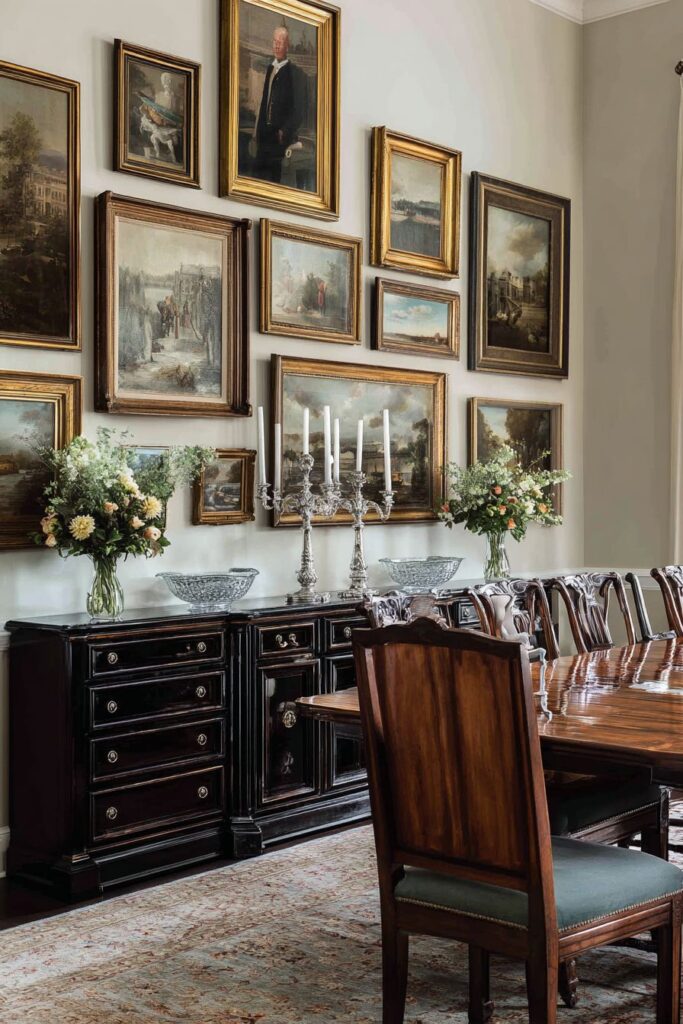
Below the artwork, the sideboard provides a platform for displaying silver candlesticks, crystal bowls, and fresh flowers that coordinate with the framed pieces above. The silver candlesticks add vertical elements that connect the horizontal sideboard surface with the wall arrangement above, while their metallic finish coordinates with frame accents. Crystal bowls catch and reflect light from multiple sources, adding sparkle that enlivens the entire vignette.
Fresh flowers in crystal or silver vessels bring life and seasonal change to this curated display, demonstrating how natural elements can enhance rather than compete with formal arrangements. The choice to include fresh flowers shows the old money understanding that even the most formal spaces benefit from natural beauty and seasonal variation. Traditional dining furniture in matching wood tones throughout the space creates continuity while allowing the heritage-focused wall display to take center stage.
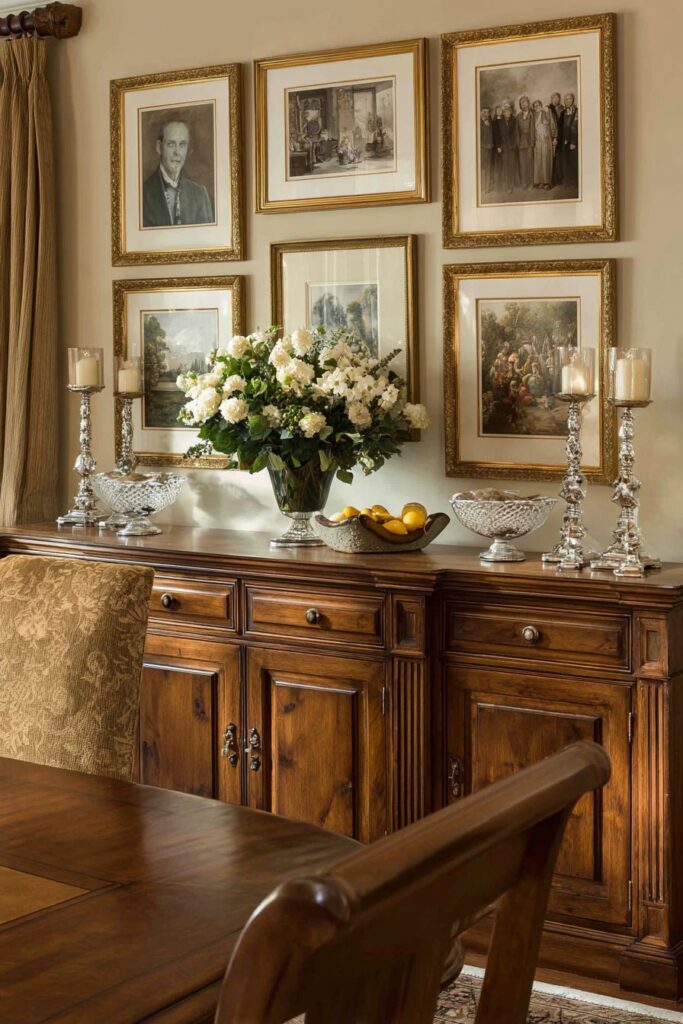
Key Design Tips:
- Arrange gallery walls with attention to both visual balance and personal significance
- Mix frame materials while maintaining coordinated finishes
- Use vertical elements on surfaces below wall arrangements to create visual connection
- Include fresh flowers to add life to formal displays
- Choose furniture finishes that support rather than compete with wall arrangements
11. Architectural Ceiling Details and Grand Scale
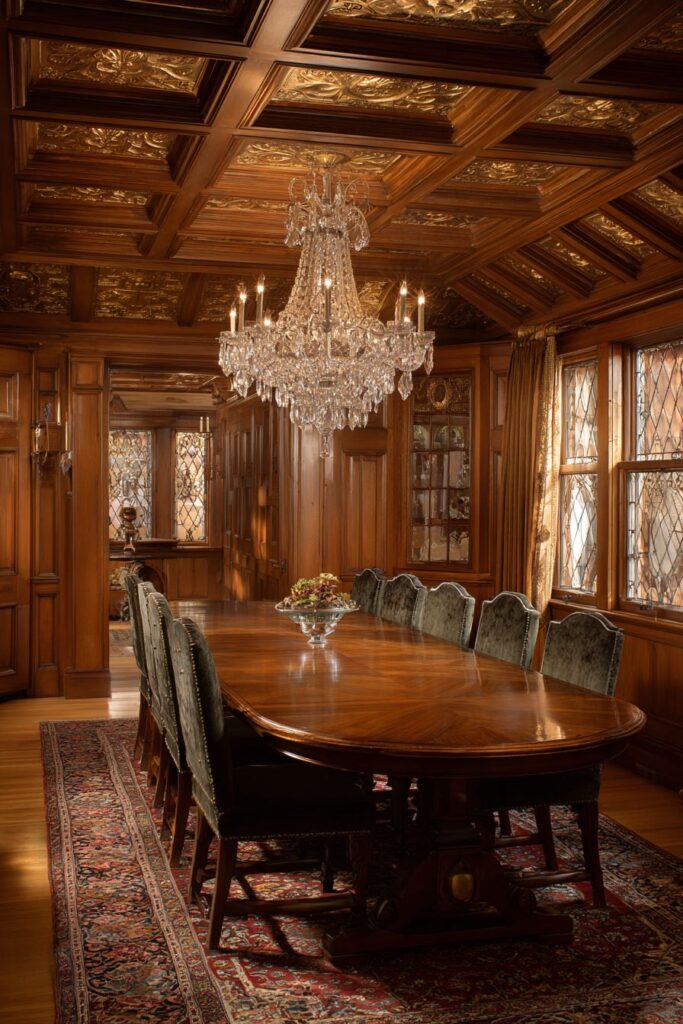
The coffered ceiling painted in warm cream with gold leaf accents in the recessed panels creates an architectural feature of extraordinary sophistication that immediately establishes this dining room’s grand aspirations. The coffers themselves represent the kind of traditional architectural detailing that speaks to quality construction and attention to historical precedent, while the warm cream paint color maintains elegance without overwhelming the space with excessive ornamentation. The gold leaf accents catch light from multiple sources, creating subtle sparkle that adds luxury without ostentation.
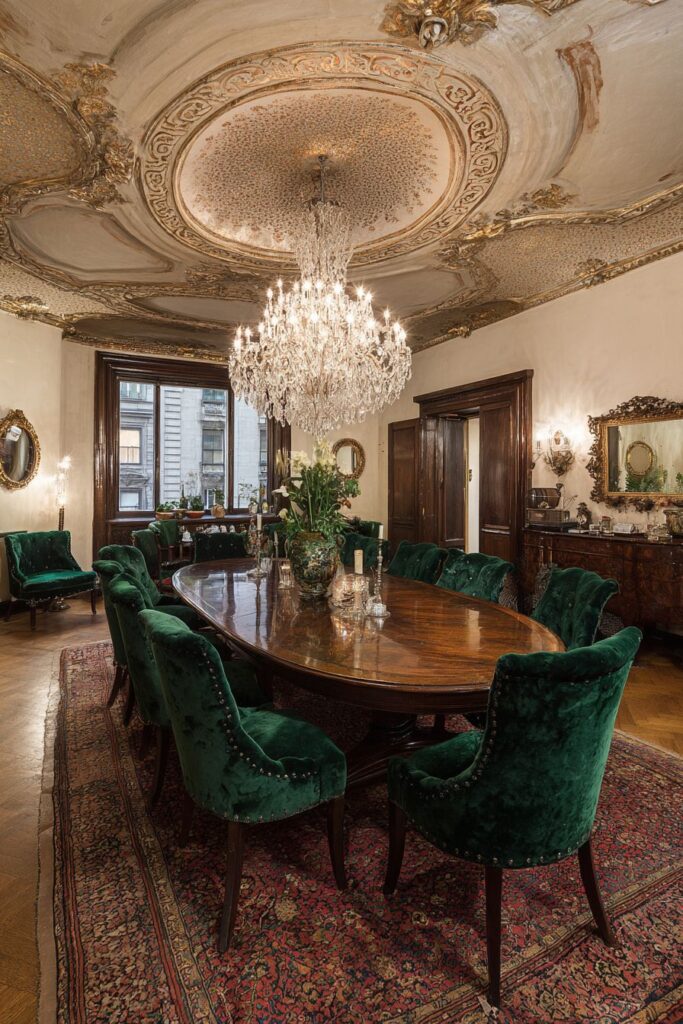
This magnificent ceiling treatment provides the perfect backdrop for the grand crystal chandelier that hangs centrally over the oval dining table, its proportions carefully calculated to complement both the ceiling’s grandeur and the table’s dimensions. The chandelier’s crystal elements refract light throughout the coffered ceiling, creating dancing patterns that bring movement and life to the architectural details above. The relationship between ceiling and chandelier demonstrates the kind of scaled thinking that characterizes successful formal dining rooms.
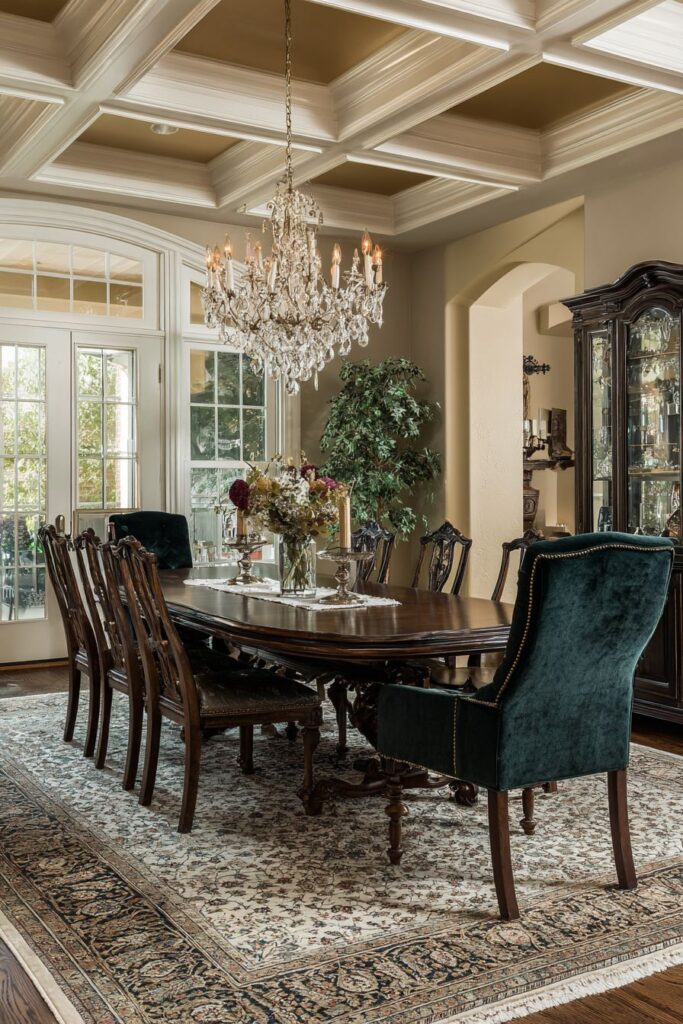
The oval dining table in dark wood with claw feet details anchors the space while providing elegant curves that soften the room’s more angular architectural elements. The claw feet represent traditional furniture detailing that speaks to quality construction and historical design precedent, while the dark wood provides sufficient visual weight to balance the ornate ceiling treatment above. The oval shape facilitates conversation while accommodating multiple guests comfortably.
Upholstered dining chairs in deep emerald velvet with brass nailheads provide seating that matches the room’s level of sophistication while adding rich color that complements the gold ceiling accents. The emerald velvet choice demonstrates confidence in color selection while remaining classic enough to work with changing table settings and seasonal decorations. The brass nailheads coordinate with ceiling accents while adding textural detail that enhances the chairs’ luxurious appearance.
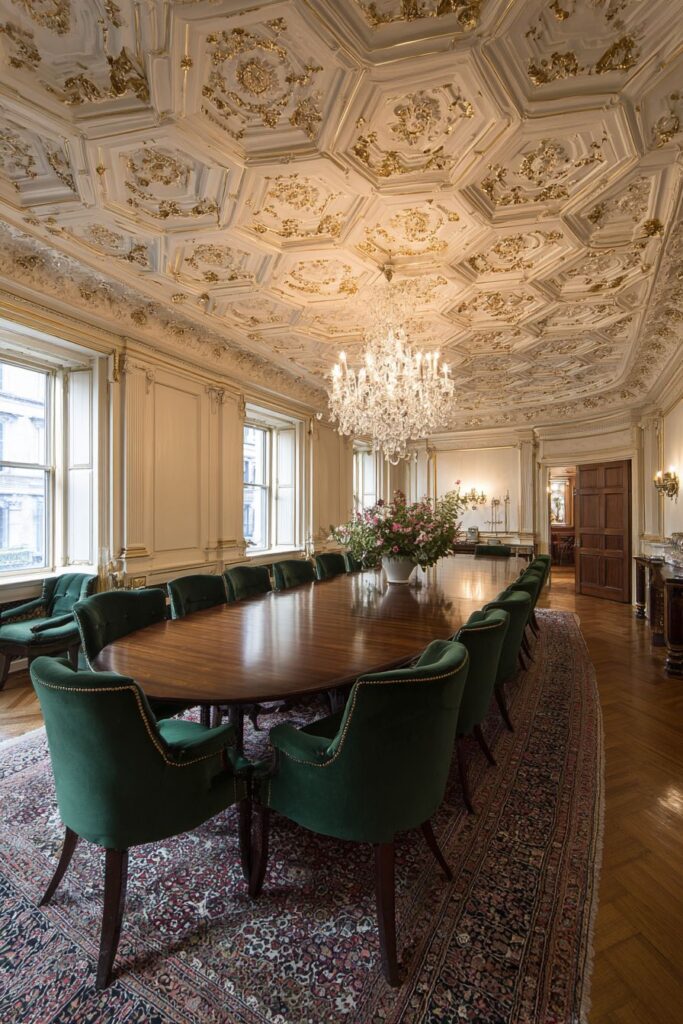
Key Design Tips:
- Design ceiling treatments that complement rather than compete with lighting fixtures
- Use gold leaf accents sparingly for maximum impact
- Select dining tables with proportions that balance architectural grandeur
- Choose upholstery colors that coordinate with architectural accent colors
- Consider how ceiling treatments interact with light sources throughout the day
12. Casual Elegance and Built-in Comfort
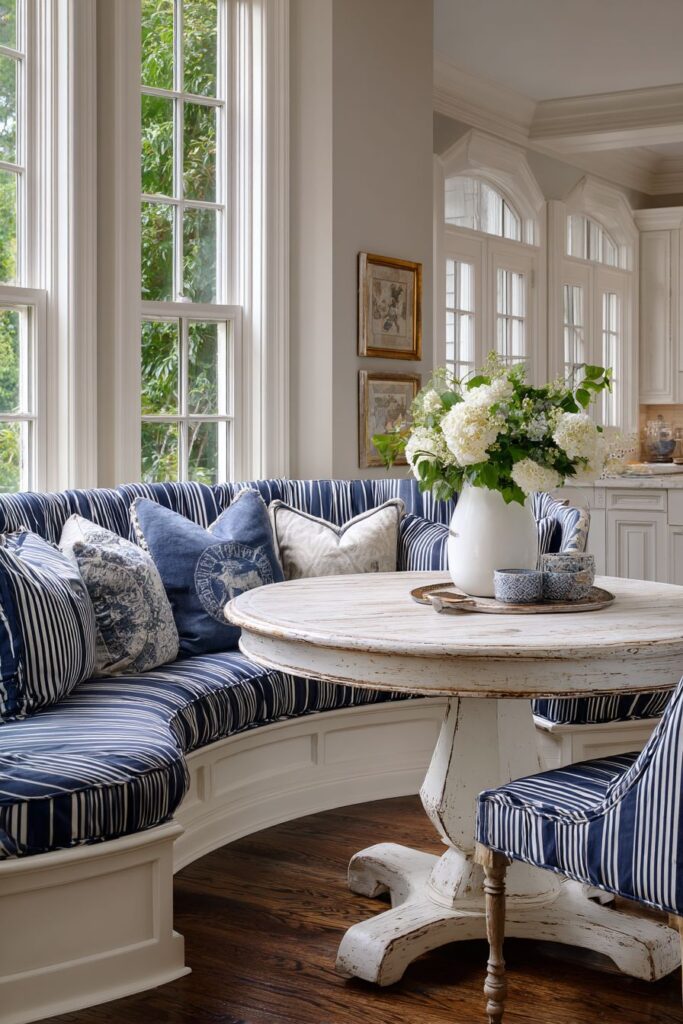
The built-in banquette seating upholstered in navy and white striped fabric creates a charming breakfast nook that demonstrates how old money design principles can be applied to more casual dining situations without sacrificing sophistication. The navy and white stripe pattern provides classic visual interest that never goes out of style, while the built-in construction maximizes seating efficiency and creates a custom appearance that integrates seamlessly with the room’s architecture. Coordinating throw pillows add comfort and color flexibility while maintaining the sophisticated color palette.
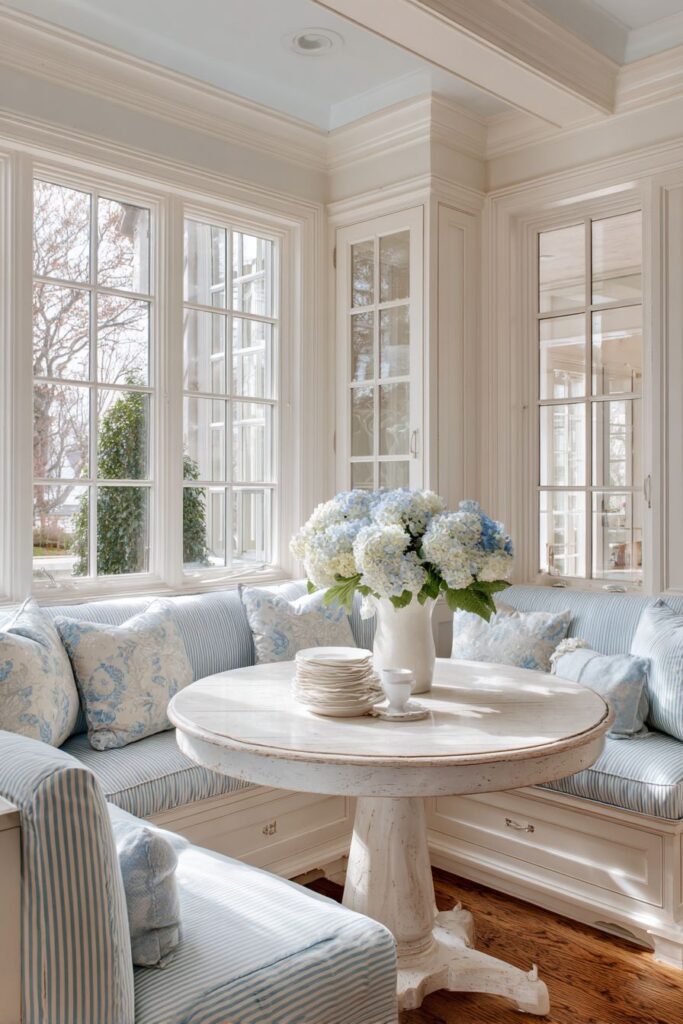
The round pedestal table in white painted wood with natural wear creates a casual dining surface that celebrates the beauty of authentic aging and family use. The white paint finish lightens the visual weight compared to darker wood options while showing gentle wear patterns that speak to generations of family meals and daily life. This approach to furniture finishing demonstrates the old money appreciation for pieces that improve with age and use rather than requiring pristine maintenance.
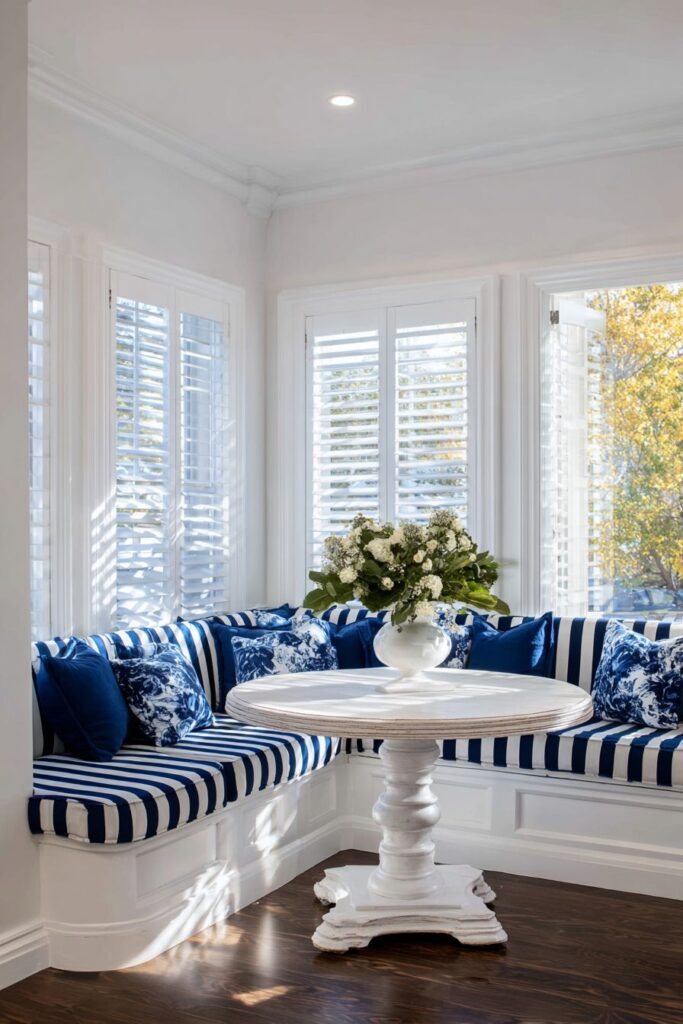
Fresh flowers in a simple white ceramic vase provide natural beauty that enhances the casual elegance without competing with the space’s architectural elements. The choice of simple white ceramic reflects the understated luxury that characterizes old money design sensibilities, where quality materials and classic forms take precedence over trendy colors or elaborate designs. The fresh flowers add life and seasonal variation while maintaining the clean, classic aesthetic.
Natural morning light streaming through nearby windows enhances the breakfast nook’s welcoming atmosphere while highlighting the fabric textures and painted wood finishes. This natural lighting creates the kind of warm, inviting ambiance that makes casual dining feel special without being overly formal. The connection to natural light patterns demonstrates how successful dining spaces work with daily rhythms and seasonal changes.
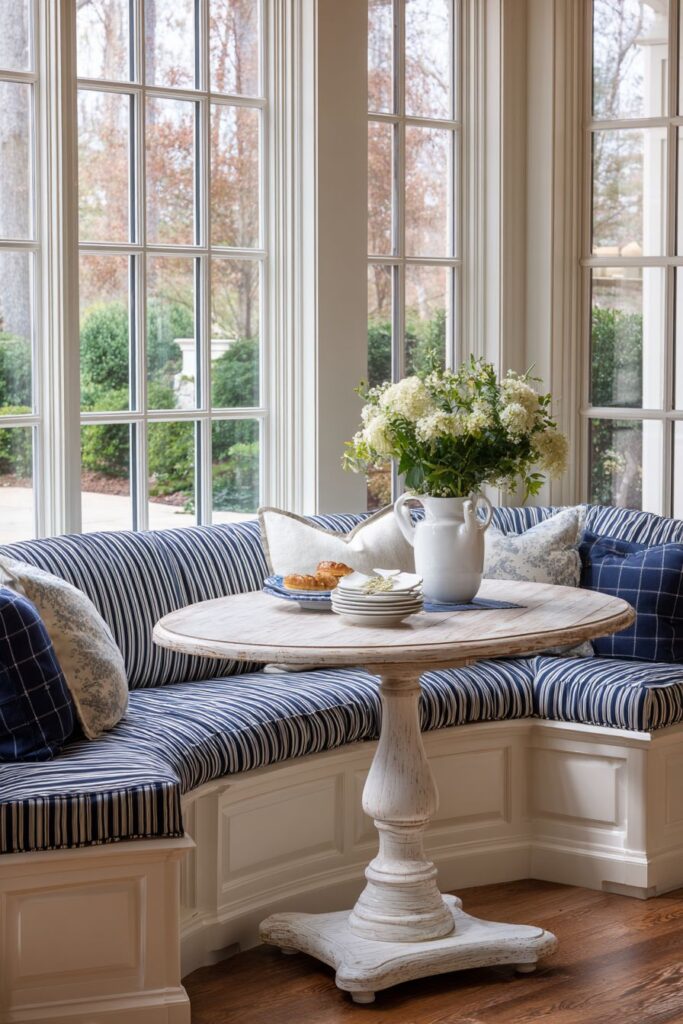
Key Design Tips:
- Use built-in seating to maximize space efficiency while creating custom appearance
- Choose classic fabric patterns like stripes that remain timeless
- Embrace natural wear patterns in painted furniture as signs of authentic family use
- Select simple ceramic accessories that support rather than dominate arrangements
- Design casual dining areas to take advantage of natural morning light
13. Porcelain Collections and Display Mastery
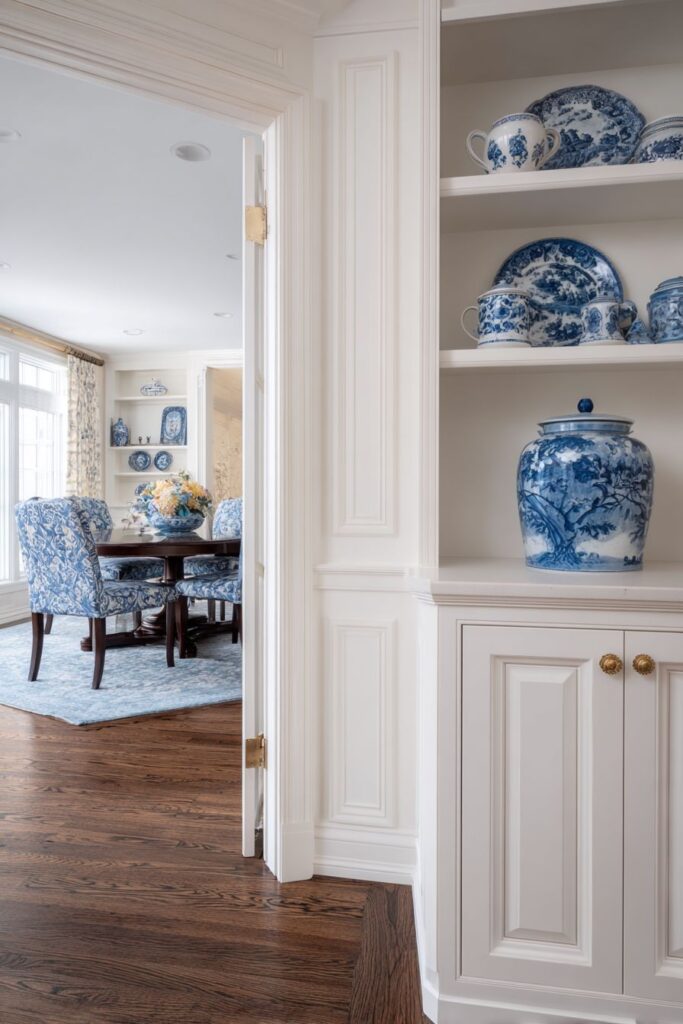
The impressive collection of blue and white porcelain displayed on open shelving represents the kind of thoughtful collecting that characterizes old money interiors, where each piece is chosen for both its individual beauty and its contribution to the overall collection. The built-in cabinetry features traditional plate grooves and specialized cabinet lighting that creates a museum-quality presentation while protecting valuable pieces from damage. This approach to display demonstrates how functional storage can become decorative art when executed with proper attention to design principles.
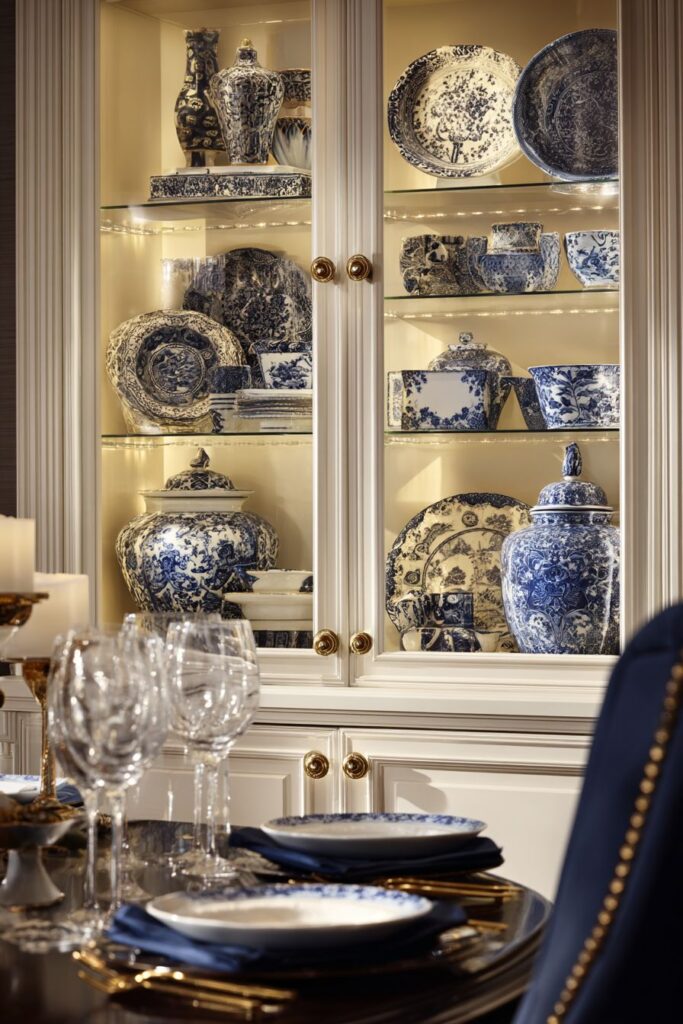
The raised panel doors in warm white paint with brass knobs coordinate with the display shelving while providing concealed storage for pieces not currently on display. This combination of open and closed storage allows for both exhibition and rotation of collections, preventing the space from appearing cluttered while ensuring that all pieces receive appropriate care and attention. The brass knobs coordinate with other metallic accents throughout the room while adding traditional hardware details.
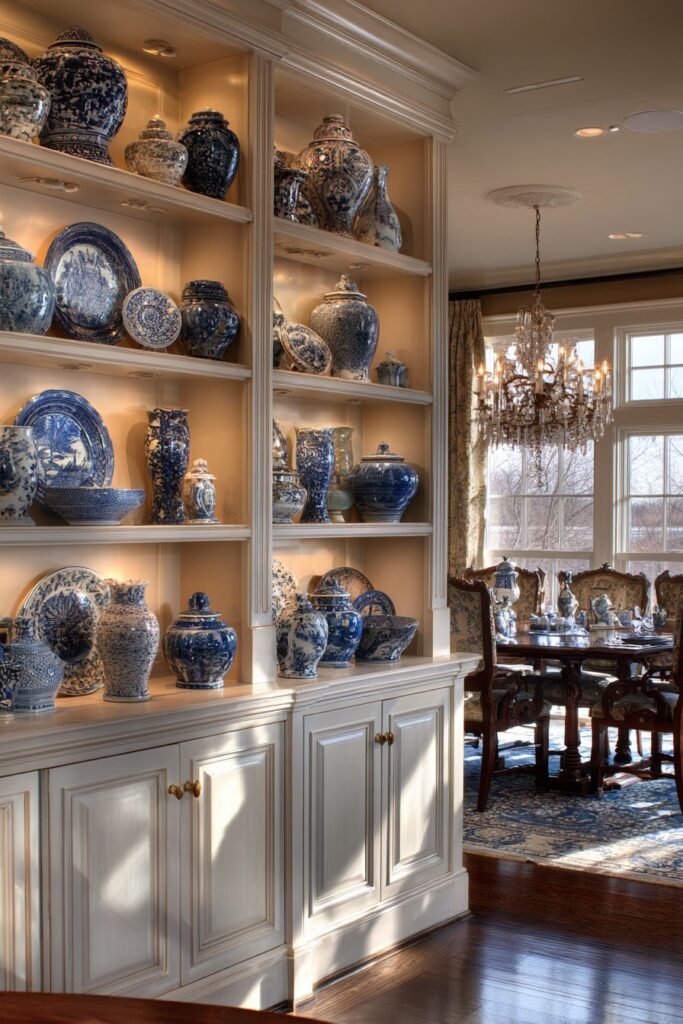
Cabinet lighting illuminates the ceramic collection’s patterns and glazes, highlighting the intricate details and artistic merit of each piece while creating visual drama that draws attention to the display. The lighting is carefully positioned to eliminate shadows and provide even illumination that showcases the porcelain’s translucent qualities and decorative details. This professional-quality lighting transforms the collection into room-defining art.
The adjacent formal dining area continues the navy and white color scheme established by the porcelain collection, creating a cohesive environment where the displayed pieces feel integrated rather than isolated. Traditional furniture elements in coordinating finishes support the collector’s aesthetic while providing functional dining space that complements the display area’s sophisticated presentation.
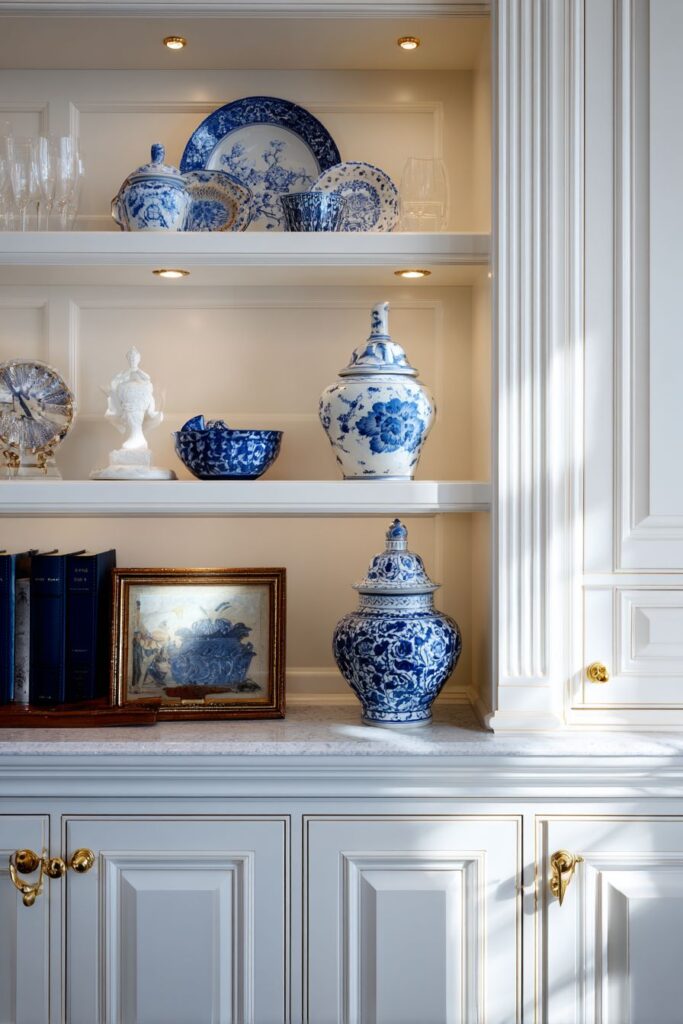
Key Design Tips:
- Design display lighting to highlight collections without creating harsh shadows
- Use raised panel cabinet doors for traditional storage solutions
- Coordinate hardware finishes throughout built-in cabinetry
- Plan collections displays with attention to both individual pieces and overall composition
- Create color schemes that integrate displayed collections with functional furniture
14. Luxurious Flooring and Persian Textile Art

The hardwood floors in rich walnut with hand-scraped texture create a foundation of natural luxury that speaks to quality construction and authentic craftsmanship techniques. The hand-scraped texture adds visual interest and tactile appeal while showcasing the wood’s natural grain variations and color depth. This flooring choice represents the kind of investment in quality materials that improves with age and use, developing character and patina that add to rather than detract from the room’s beauty over time.

The natural color variation in the walnut flooring provides a rich backdrop that complements traditional furniture while adding depth and visual interest to the room’s foundation. This variation demonstrates the beauty of natural materials and authentic wood characteristics that cannot be replicated in synthetic alternatives. The rich brown tones provide warmth and sophistication that works beautifully with both light and dark furniture choices.
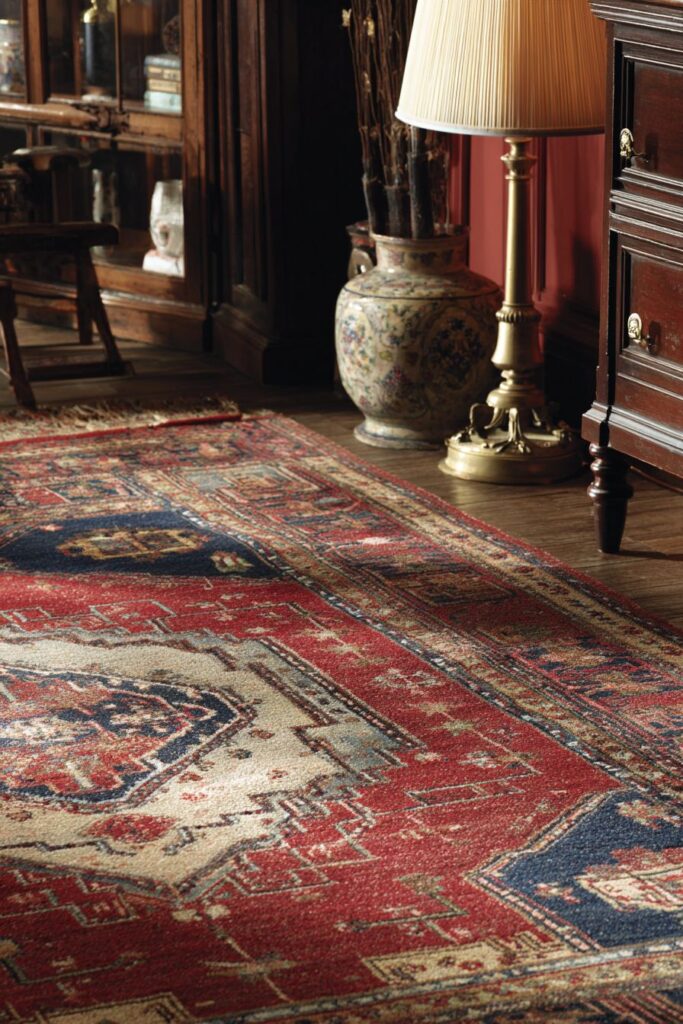
Covering this magnificent flooring, an antique Persian rug in deep reds and golds with intricate border patterns provides textile art that anchors the dining area while adding layers of color, pattern, and cultural significance. The deep red background color coordinates beautifully with the walnut flooring while providing enough contrast to define the dining area within the larger space. The intricate border patterns demonstrate the kind of craftsmanship and artistic tradition that characterizes genuine Persian textile art.
Traditional dining furniture in matching walnut wood tones sits harmoniously atop this textile foundation, creating a cohesive environment where flooring, textiles, and furniture work together to support the room’s sophisticated aesthetic. The coordination of wood tones prevents the space from appearing busy while allowing each element to contribute its unique texture and character to the overall composition.
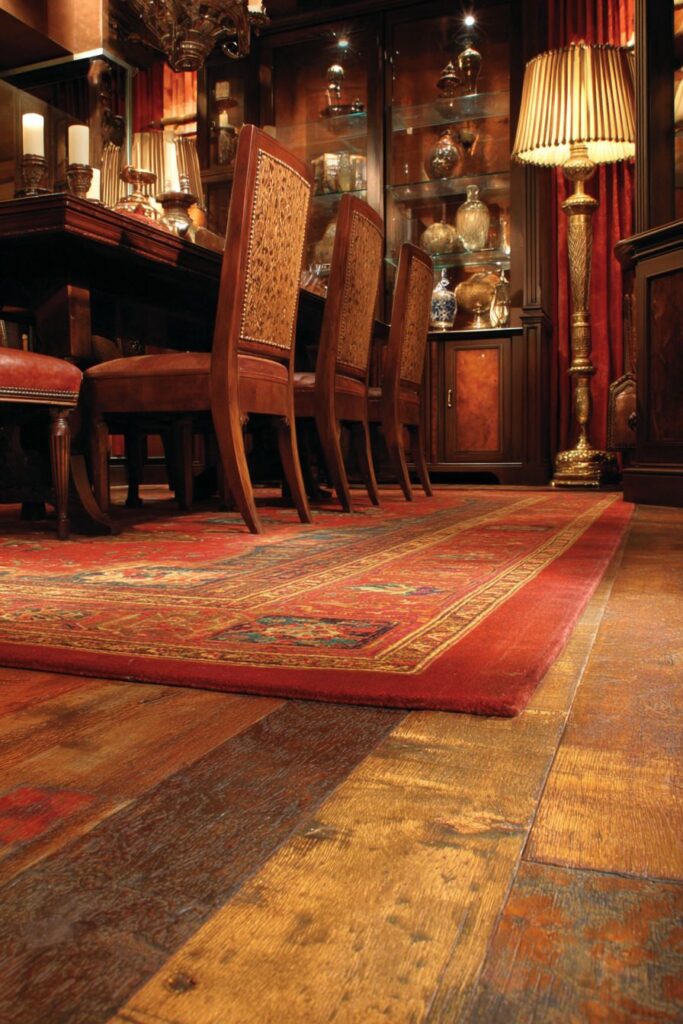
Key Design Tips:
- Choose hand-scraped hardwood flooring for authentic texture and character
- Embrace natural wood color variation as evidence of genuine materials
- Select Persian rugs with borders that help define dining areas
- Coordinate furniture wood tones with flooring for cohesive color stories
- Layer textile and wood elements for rich, sophisticated material combinations
15. Indoor-Outdoor Connection and Garden Views
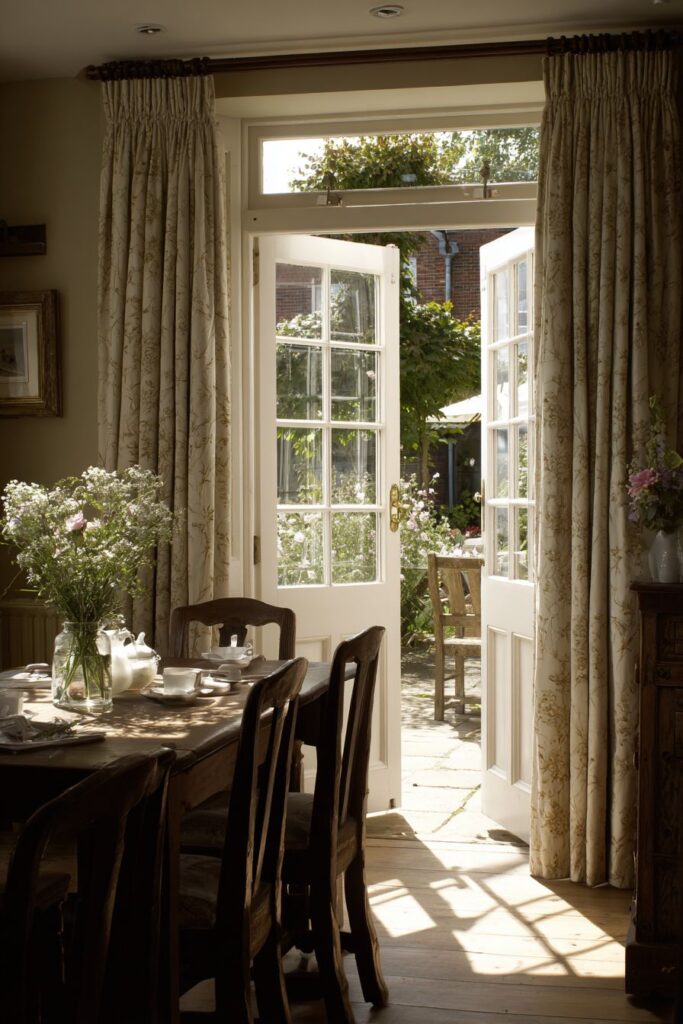
The French doors with divided light windows create an elegant transition between the formal dining room and outdoor garden spaces, bringing natural light and garden views into the interior while maintaining the architectural sophistication appropriate for a formal dining environment. The divided light pattern adds traditional architectural detail that coordinates with the room’s classical design elements while creating visual interest in the door and window composition.
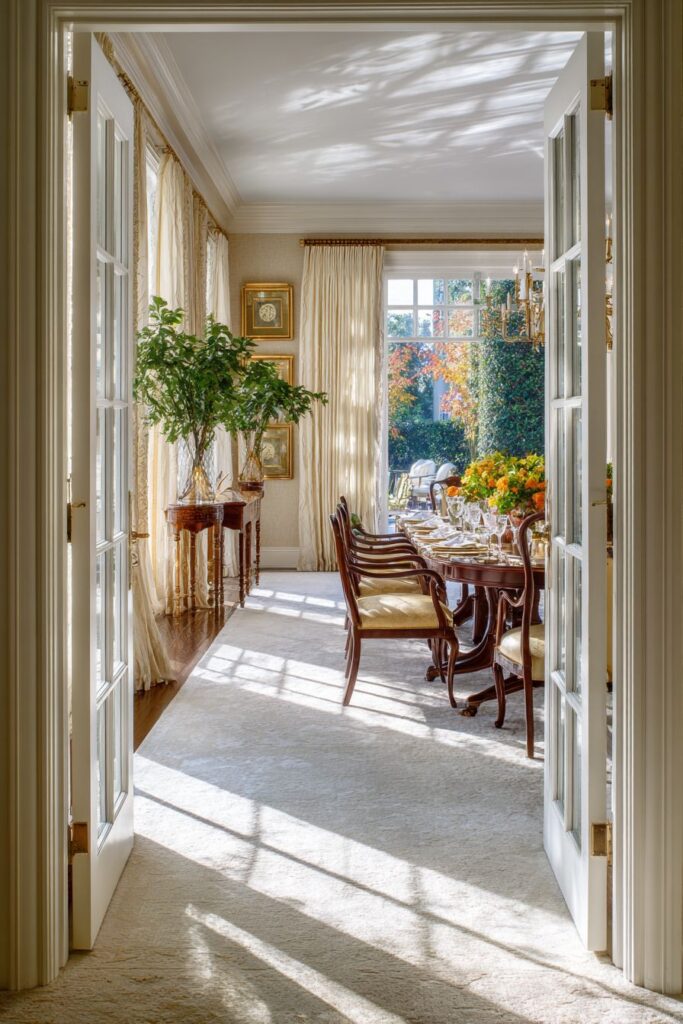
Floor-length curtains in cream silk with subtle sheen provide privacy and light control while adding luxury through their material quality and generous proportions. The cream color remains neutral enough to work with changing garden views throughout the seasons while the silk’s natural sheen adds movement and light reflection that enhances the room’s overall luminosity. The floor-length treatment creates dramatic vertical lines that emphasize the room’s architectural proportions.
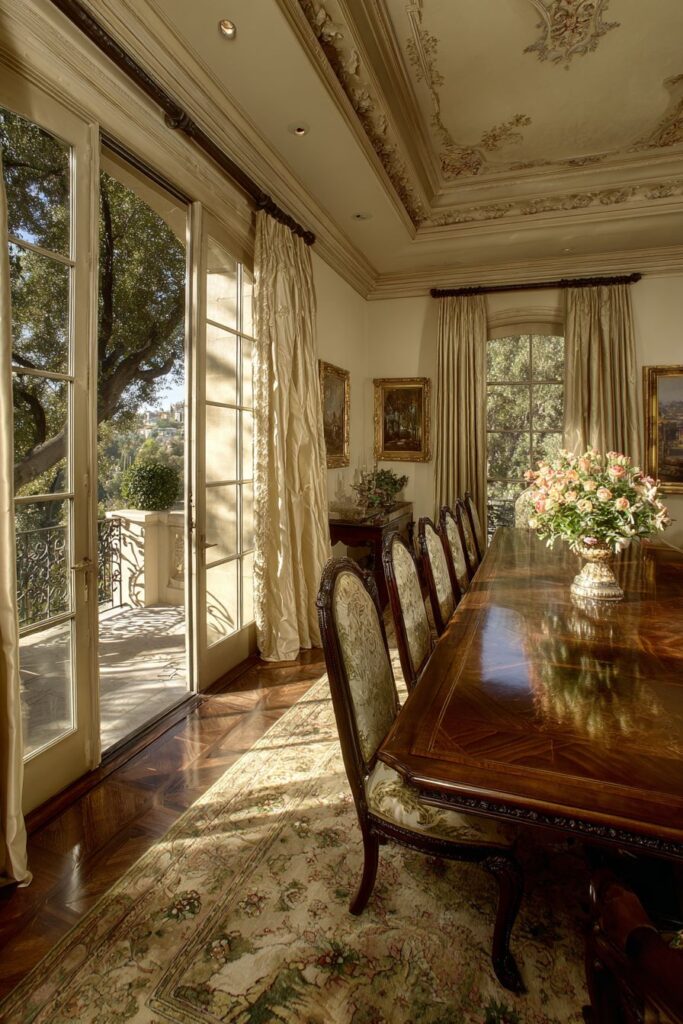
Natural light filtering through these carefully chosen treatments creates dappled patterns on traditional dining furniture in rich wood tones, connecting the interior dining experience with the natural rhythms and beauty of outdoor spaces. This filtered light takes on different qualities throughout the day, creating changing moods and highlighting different aspects of the room’s materials and furnishings as the sun moves across the sky.
Fresh garden flowers brought inside create a direct connection between interior and exterior spaces, demonstrating how old money design principles embrace seasonal beauty and natural elements. The choice to bring garden flowers inside shows an appreciation for natural cycles and seasonal change while adding fresh color and fragrance that enhance the dining experience. This practice creates a living connection between formal interior spaces and natural outdoor environments.
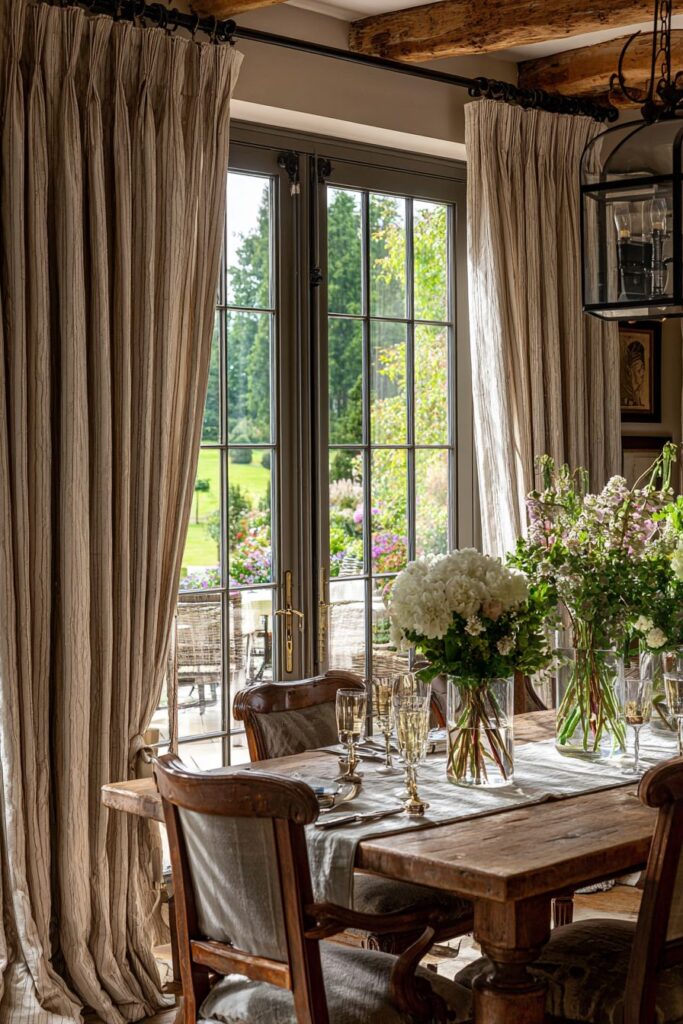
Key Design Tips:
- Use divided light windows for traditional architectural detail
- Choose floor-length silk treatments for maximum luxury impact
- Plan interior lighting to work with changing natural light throughout the day
- Bring garden flowers inside to connect interior and exterior environments
- Consider how window treatments filter and modify natural light quality
16. Sophisticated Entertaining Accessories
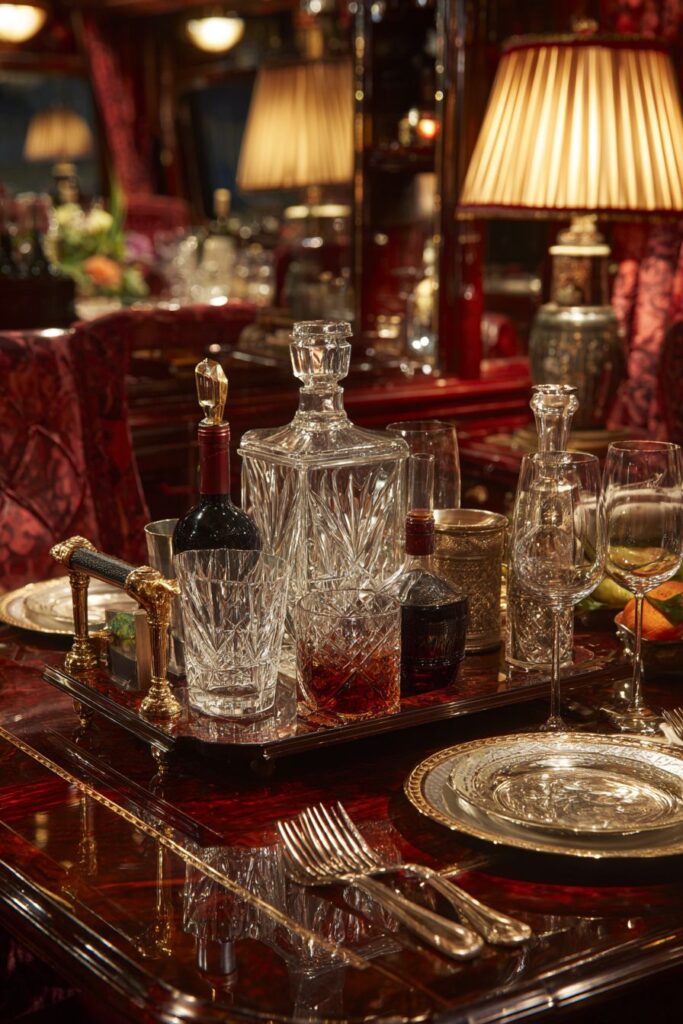
The formal bar cart in brass and wood represents the perfect marriage of functionality and elegance, providing mobile entertaining capabilities while adding sophisticated metallic and wood accents that coordinate with fixed dining room furniture. The brass framework adds warmth and traditional metallic detailing while the wood shelving provides practical storage that complements the room’s overall wood tone palette. This mobile piece demonstrates how accessories can enhance rather than clutter formal dining environments.
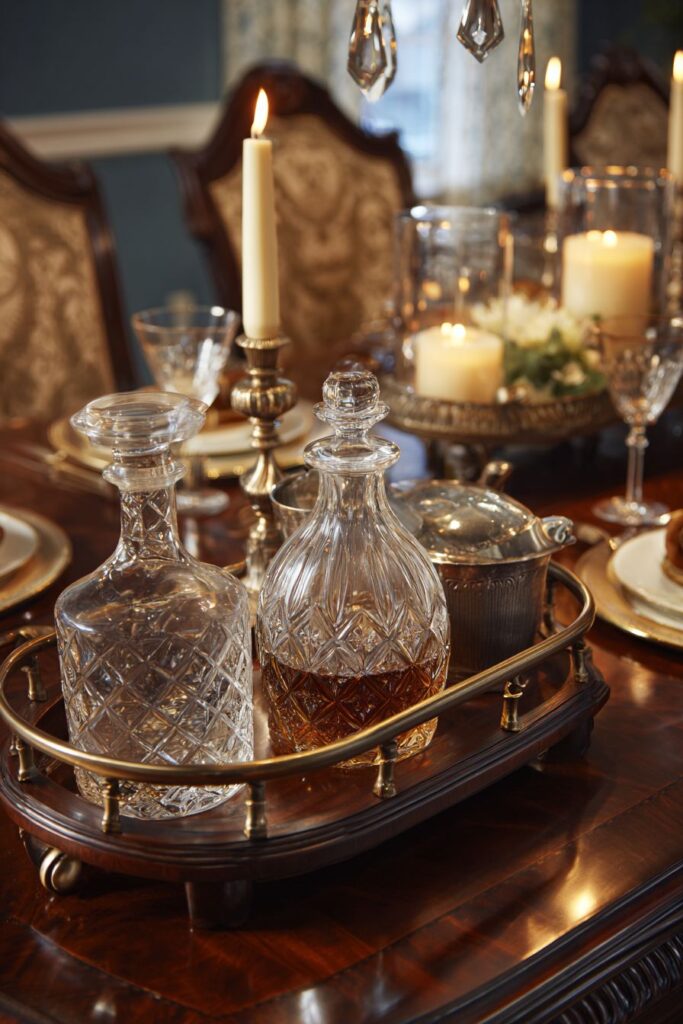
Crystal decanters arranged on the cart catch and refract ambient lighting throughout the space, creating sparkling focal points that add life and movement to the room’s sophisticated atmosphere. The crystal’s faceted surfaces create prismatic effects that enhance the room’s lighting while the decanters themselves represent the kind of quality accessories that improve with age and proper care. Silver ice bucket and fine glassware complete the entertaining ensemble with pieces chosen for both beauty and function.
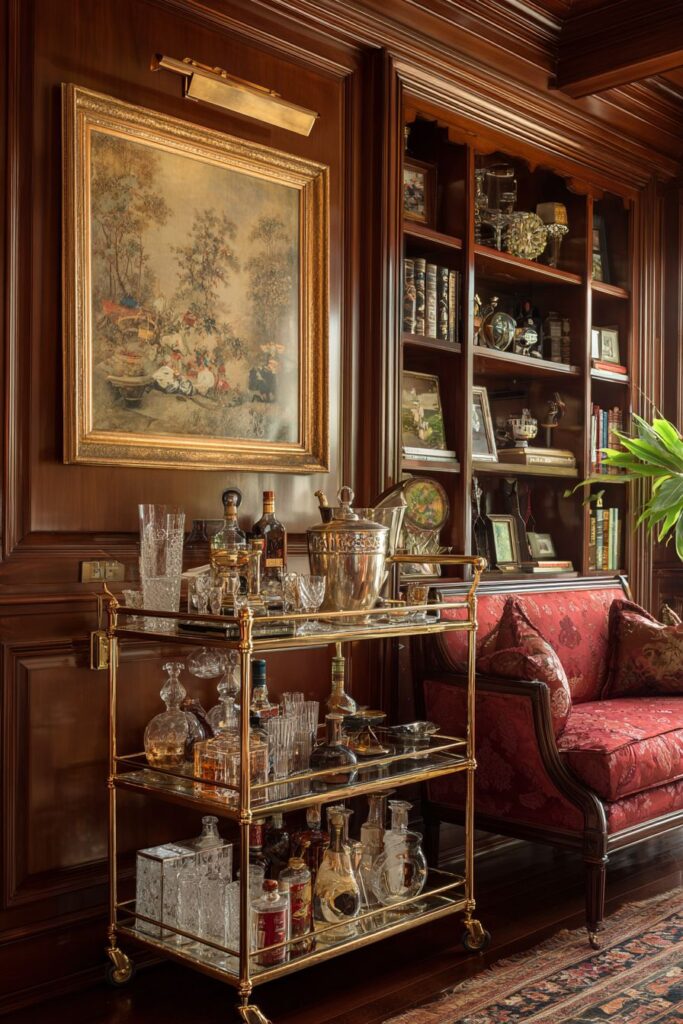
The bar cart’s crystal and silver elements coordinate with fixed traditional furniture in matching rich wood finishes, creating a cohesive environment where mobile and permanent pieces work together harmoniously. This coordination prevents the space from appearing cluttered with competing elements while ensuring that all pieces contribute to the room’s overall sophisticated aesthetic. The rich wood finishes provide continuity that ties mobile and fixed elements together.
The adjacent formal dining area shows how coordinating traditional appointments create environments where entertaining accessories feel integrated rather than added as afterthoughts. This approach to accessory selection demonstrates the old money principle of choosing pieces that serve multiple purposes while contributing to the overall design aesthetic rather than simply filling space with decorative objects.
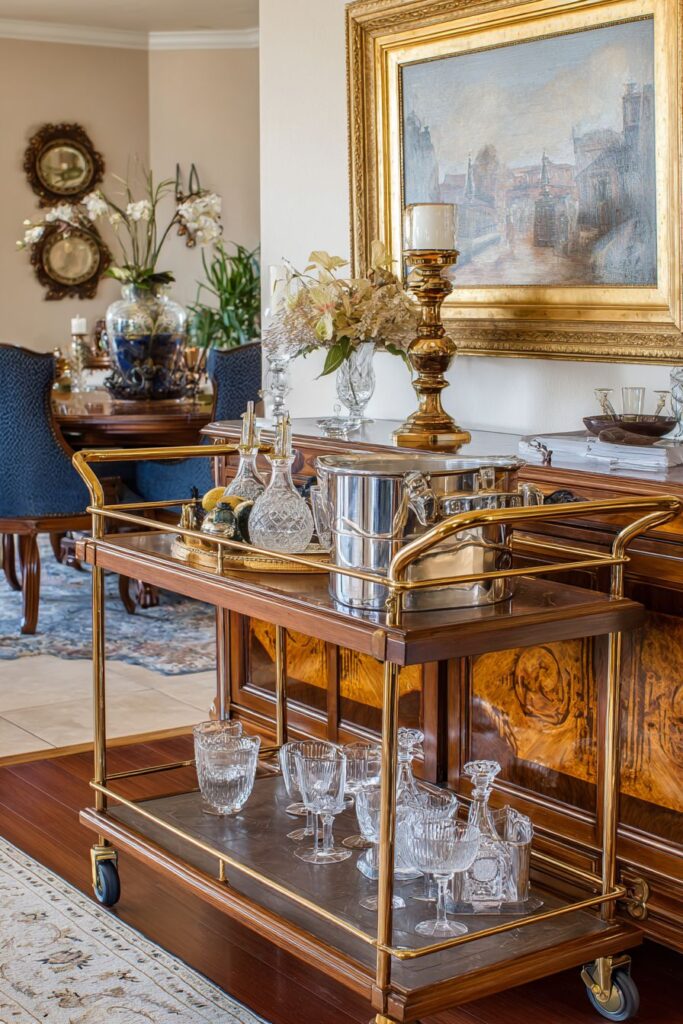
Key Design Tips:
- Choose bar carts that coordinate with rather than compete with fixed furniture
- Select crystal accessories for their light-refracting properties
- Coordinate metallic finishes between mobile and fixed elements
- Plan entertaining accessories as integrated parts of overall design schemes
- Consider how accessories contribute to room lighting and atmosphere
17. Fine Table Linen and Monogrammed Details
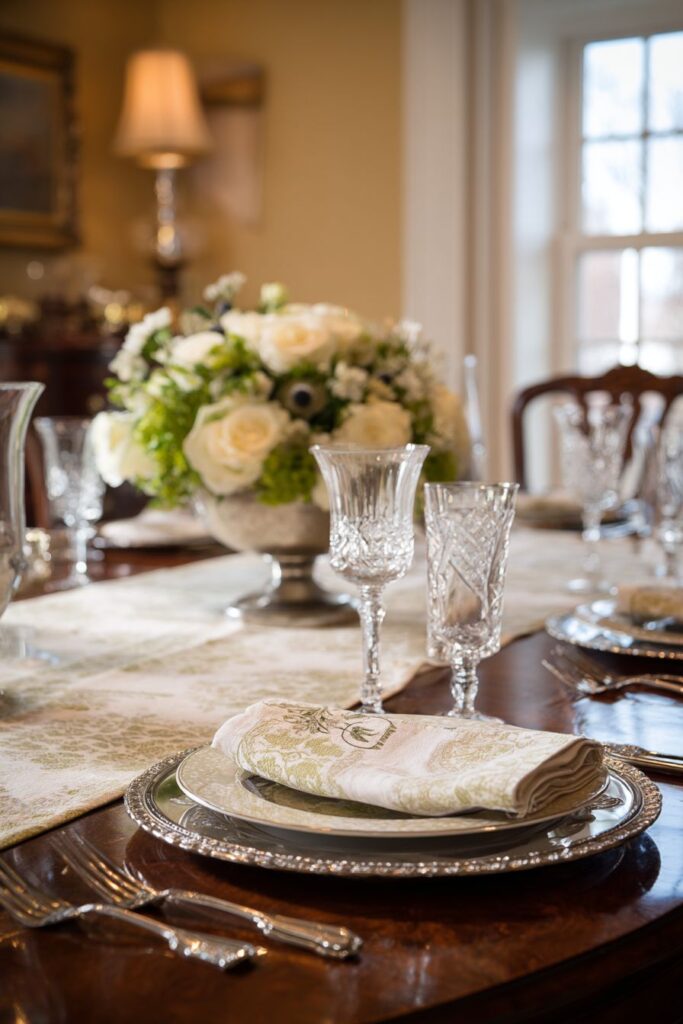
The traditional table linens in this sophisticated dining room demonstrate how attention to textile details can elevate formal dining from merely functional to truly memorable. Embroidered placemats provide individual place definition while adding handcrafted details that speak to quality and tradition. The embroidery work represents the kind of fine craftsmanship that has been valued by discerning families for generations, creating pieces that improve with proper care and become more meaningful over time.
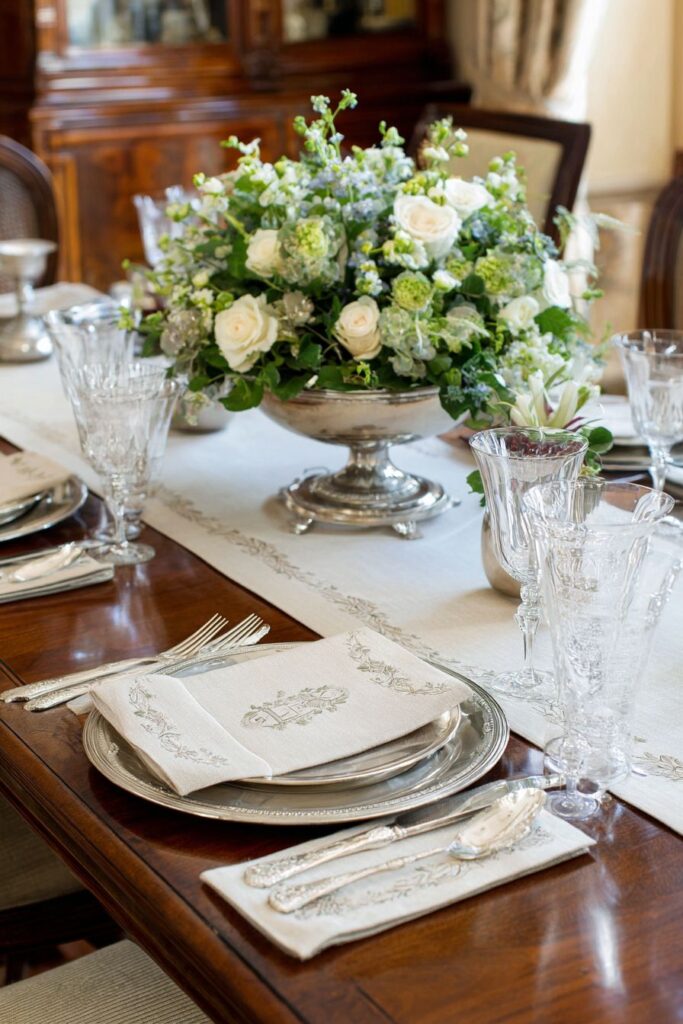
Cloth napkins with monogrammed details add personal significance while demonstrating the old money tradition of marking quality linens with family initials or crests. These monograms transform functional items into family heirlooms that carry personal and historical significance beyond their practical value. The monogramming also represents the kind of attention to detail that characterizes households committed to maintaining traditional standards of formal entertaining.
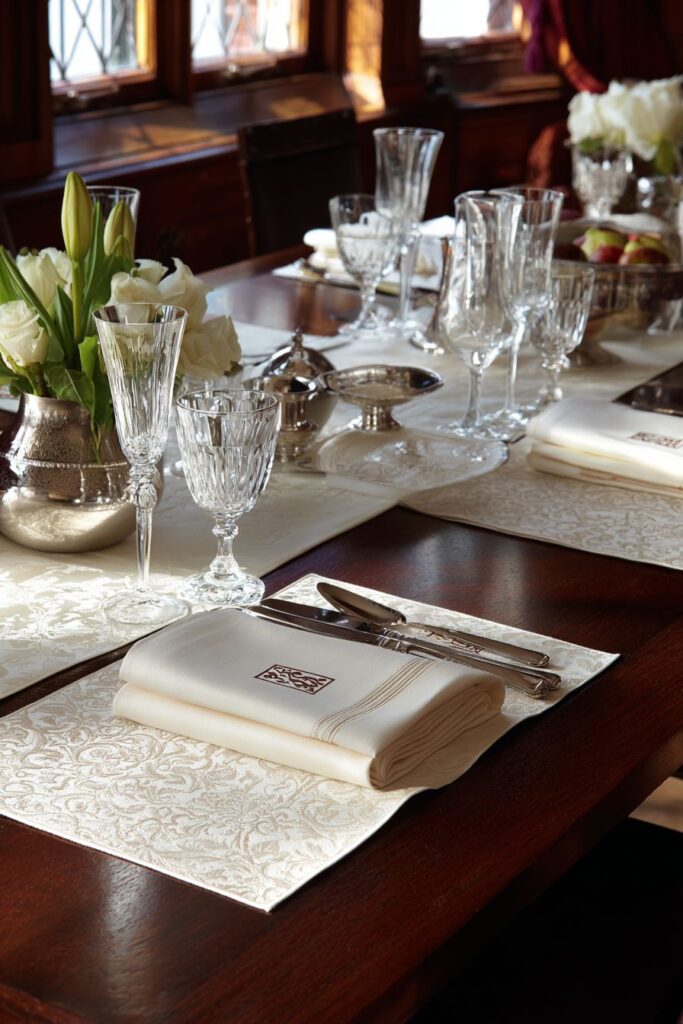
The table runner in ivory linen with subtle texture provides a foundation for the formal place settings while adding another layer of natural fiber luxury. The ivory color works beautifully with both silver and crystal elements while remaining neutral enough to accommodate seasonal decorations and changing flower arrangements. The linen’s subtle texture adds visual interest without competing with other decorative elements on the table’s surface.
Sterling silver charger plates and crystal glasses complete each place setting with pieces chosen for their individual quality and their contribution to the overall formal presentation. The silver chargers add metallic accent and formal ceremony to each place while the crystal glasses provide sparkling elements that enhance the table’s overall luminosity. Fresh flowers in a low silver bowl maintain the sophisticated aesthetic while adding natural beauty that connects the formal presentation with seasonal change.
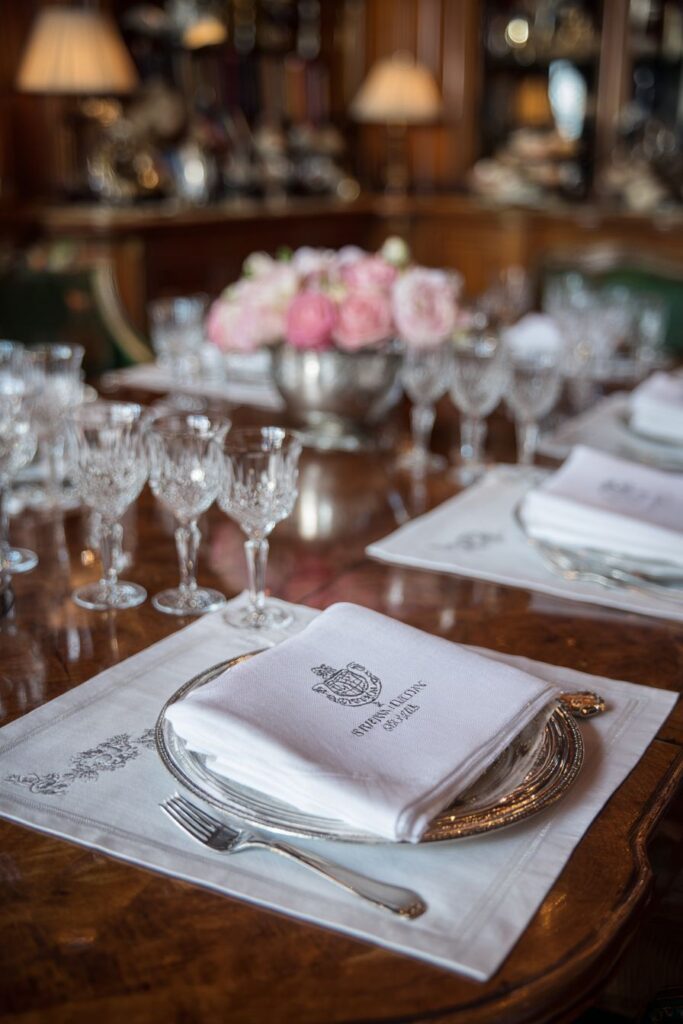
Key Design Tips:
- Choose table linens with handcrafted details like embroidery
- Add monogrammed elements for personal and family significance
- Use ivory or cream base colors for maximum versatility
- Select charger plates that coordinate with flatware finishes
- Keep centerpieces low to encourage conversation across the table
18. Fireplace Integration and Family Focus
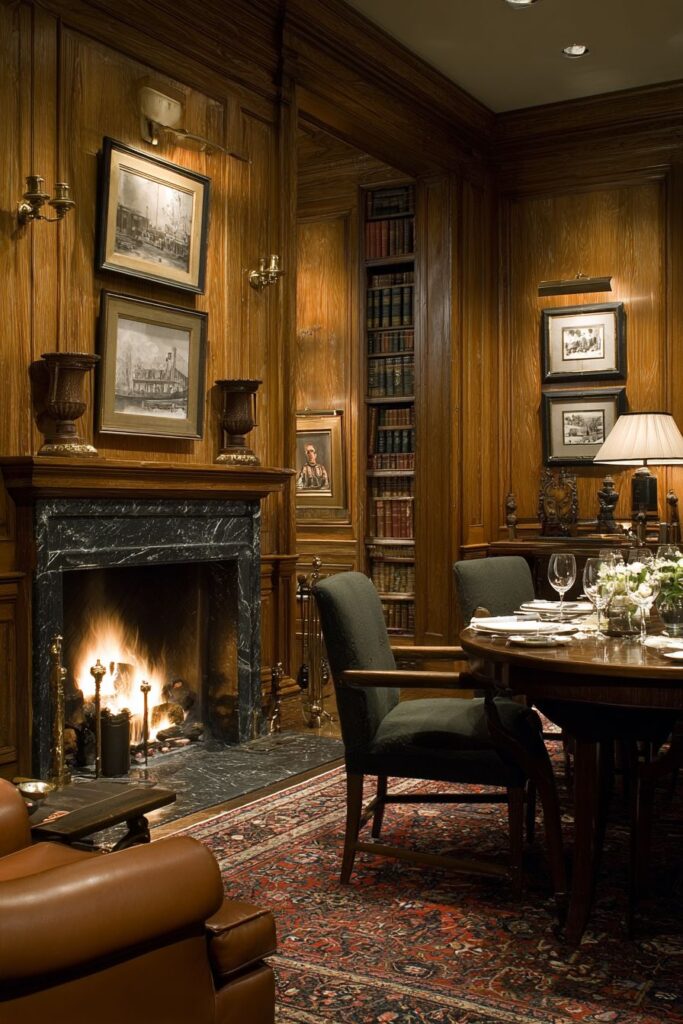
The traditional fireplace with marble surround and brass andirons creates a magnificent focal point that adds both architectural interest and cozy warmth to the formal dining environment. The marble surround represents quality materials chosen for their durability and timeless beauty, while the brass andirons provide functional fire management with decorative details that coordinate with other metallic accents throughout the room. This fireplace becomes both practical heat source and impressive architectural feature.

Family photographs in silver frames arranged on the mantel create a personal gallery that transforms the fireplace surround into a celebration of family history and relationships. The silver frames coordinate with other metallic elements while providing elegant presentation for treasured family images. This arrangement demonstrates how formal spaces can maintain sophisticated aesthetics while celebrating personal relationships and family heritage.
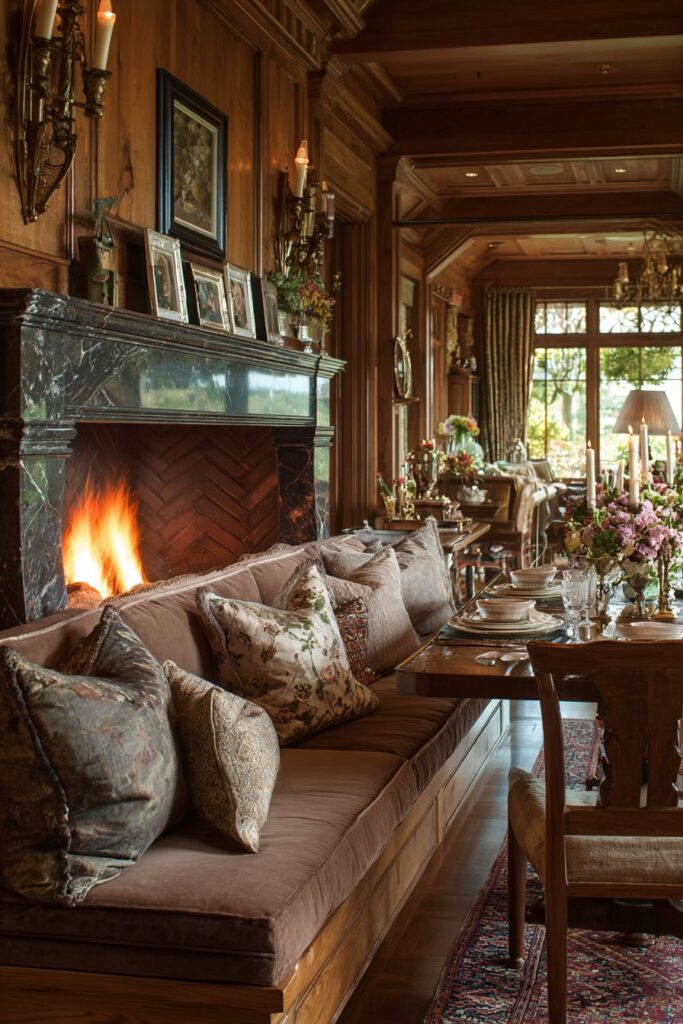
The adjacent dining area continues the family-focused theme with traditional furniture in warm wood tones and upholstered seating in muted colors that create comfortable, inviting spaces for family gatherings. The warm wood tones coordinate with the fireplace’s architectural elements while the muted upholstery colors provide sophistication without intimidating family members or guests. This balance between formality and comfort characterizes the best old money dining environments.
Persian rug anchoring the seating area provides color foundation while adding textile luxury that complements the room’s traditional aesthetic. The rug’s intricate patterns and rich colors create visual interest while the quality construction ensures longevity that makes this piece a worthwhile investment. Natural and firelight work together to create warm ambiance throughout the space, enhancing both daytime and evening dining experiences.
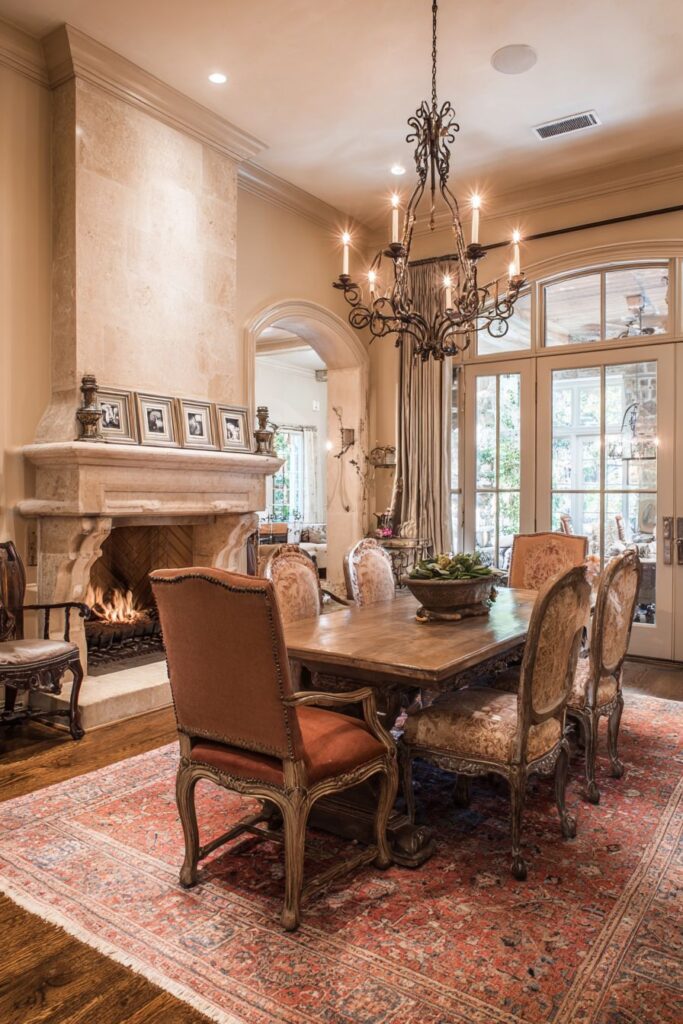
Key Design Tips:
- Use marble fireplace surrounds for timeless architectural impact
- Display family photographs in coordinated metallic frames
- Choose upholstery colors that balance sophistication with comfort
- Select Persian rugs that provide color foundation for seating areas
- Plan lighting to work with both natural and firelight sources
19. Traditional Storage Solutions and China Display

The traditional breakfront china cabinet in cherry wood represents the ultimate fusion of storage functionality and display artistry, providing specialized accommodation for fine china service and crystal stemware collections while creating an impressive furniture piece that anchors the dining room’s traditional aesthetic. The cherry wood construction demonstrates quality materials and traditional joinery techniques that ensure longevity while developing beautiful patina over time.

Glass-front upper cabinets allow for display of fine china services and crystal stemware while protecting valuable pieces from dust and damage. The glass fronts also create opportunities for interior lighting to showcase collections while adding reflective surfaces that enhance the room’s overall luminosity. Lower cabinet doors with raised panels provide concealed storage for linens and serving pieces that require protection but don’t need constant display.

Brass hardware throughout the piece coordinates with other metallic accents in the room while providing functional access to all storage compartments. The brass finish adds warmth and traditional detailing while the quality construction ensures smooth operation that will improve rather than deteriorate with age and use. Interior cabinet lighting highlights displayed items while creating dramatic focal points that draw attention to the cabinet’s contents.
The coordinating dining furniture continues the rich wood theme throughout the space, creating a cohesive environment where storage and seating elements work together harmoniously. This coordination prevents the space from appearing busy with competing wood tones while allowing each piece to contribute its unique function to the room’s overall utility and beauty.

Key Design Tips:
- Choose breakfront cabinets for maximum storage and display flexibility
- Use interior lighting to transform storage into dramatic displays
- Coordinate wood finishes throughout fixed furniture pieces
- Select brass hardware for warmth and traditional appeal
- Plan storage solutions that accommodate both display and protection needs
20. Architectural Molding and Classic Proportions
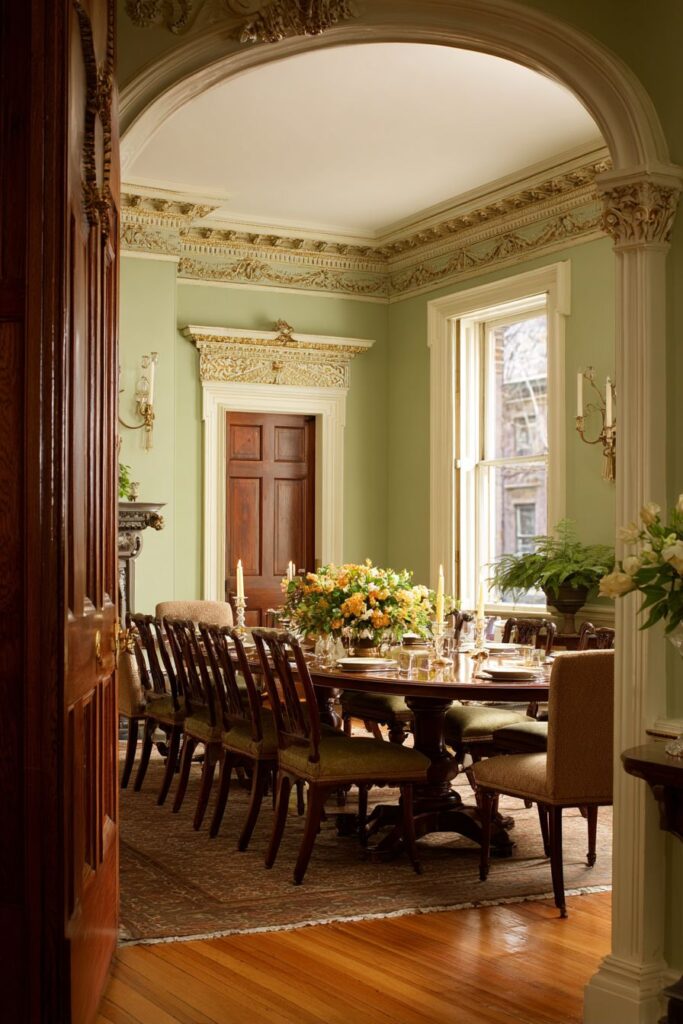
The traditional architectural molding including crown molding, chair rail, and baseboard trim creates a sophisticated framework that transforms simple walls into elegant architectural features worthy of the finest formal dining rooms. These molding details represent quality construction and attention to historical precedent while providing visual interest and traditional proportions that enhance rather than compete with furniture and accessories. The warm cream paint finish maintains elegance while providing neutral backdrop for changing decorative elements.
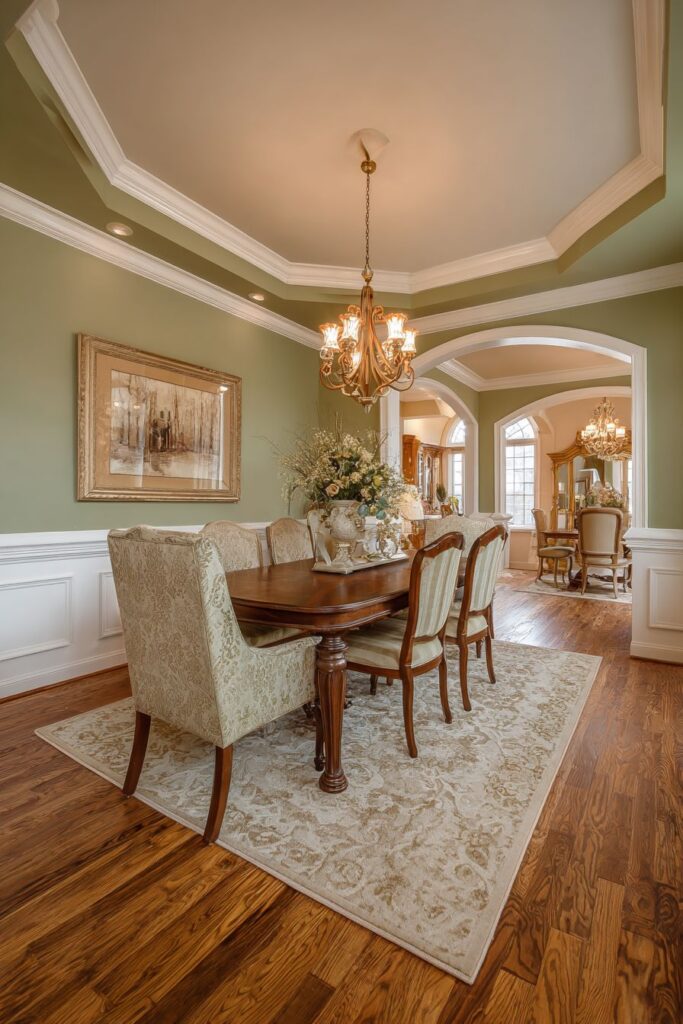
Sage green walls above the chair rail add subtle color that coordinates beautifully with traditional furniture while remaining sophisticated enough for formal entertaining. This color choice demonstrates confidence in design decisions while maintaining the kind of timeless appeal that ensures the room will remain beautiful for decades. The sage green provides enough color interest to prevent the space from appearing bland while remaining subtle enough to work with changing table settings and seasonal decorations.
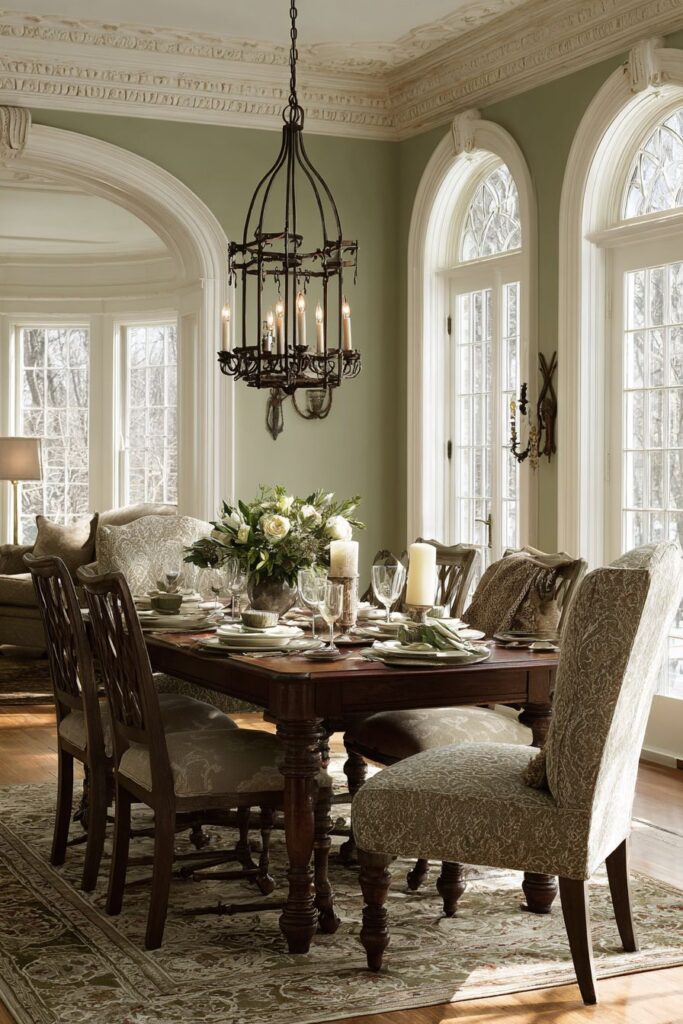
The rectangular dining table in mahogany with traditional turned legs centers the space with furniture that matches the room’s architectural sophistication. The turned legs represent traditional furniture detailing that speaks to quality construction and historical design precedent while the mahogany wood provides rich color that coordinates beautifully with the room’s warm cream and sage green color palette. The table’s proportions are carefully chosen to balance the room’s architectural grandeur.
Upholstered side chairs in coordinating fabric provide comfortable seating that matches the room’s level of sophistication while maintaining classic proportions that work harmoniously with both table and architectural details. The fabric choice coordinates with the wall color palette while providing texture and visual interest that enhance the room’s overall comfort level. Classic proportions ensure that these chairs will remain beautiful and appropriate regardless of changing fashion trends.
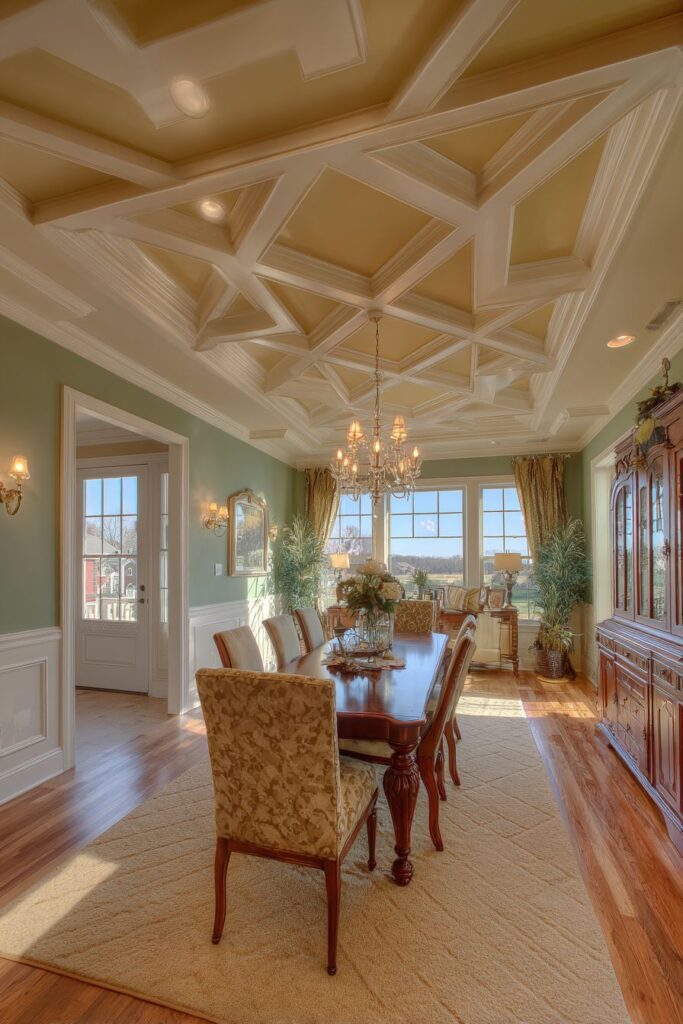
Key Design Tips:
- Use architectural molding to create sophisticated wall treatments
- Choose paint colors that coordinate with traditional furniture finishes
- Select dining tables with turned legs for traditional furniture detailing
- Coordinate upholstery fabrics with wall color palettes
- Maintain classic furniture proportions for timeless appeal
Why These Old Money Dining Room Designs Represent the Best in Timeless Elegance
These twenty dining room designs embody the finest principles of old money interior design through their unwavering commitment to quality materials, timeless proportions, and sophisticated color palettes that transcend temporary trends. Each design demonstrates the old money preference for natural materials like mahogany, walnut, and cherry wood that improve with age, developing rich patina and character that synthetic alternatives cannot replicate. The emphasis on crystal chandeliers, Persian rugs, and fine textiles reflects a design philosophy that values craftsmanship and heritage over novelty and fashion.
The color palettes consistently feature sophisticated combinations of navy, forest green, burgundy, and cream that create environments both impressive and livable. These colors work harmoniously with natural wood tones while providing enough variety to prevent monotony, demonstrating how restrained color choices can create more impactful and lasting beauty than trendy palettes that quickly become dated. The integration of brass and silver metallic accents adds warmth and sparkle without overwhelming the natural material palette.
Architectural details like coffered ceilings, wainscoting, and traditional molding work create the kind of sophisticated backgrounds that elevate furniture and accessories while providing lasting structural beauty that improves property values. These details represent investments in quality construction that pay dividends over decades rather than years, demonstrating the old money principle of buying the best possible quality initially rather than replacing inferior items repeatedly.
The emphasis on family heirlooms, fine china collections, and monogrammed linens reflects the old money understanding that dining rooms serve as repositories of family history and tradition. These personal touches transform formal spaces into meaningful environments that celebrate relationships and heritage while maintaining the sophisticated aesthetics appropriate for serious entertaining. The balance between formality and warmth creates spaces that honor both tradition and comfort.
Each design demonstrates how proper furniture proportions, quality upholstery choices, and thoughtful lighting create environments that feel both grand and intimate. The use of Persian rugs, crystal accessories, and fresh flowers adds layers of luxury that enhance rather than overwhelm the fundamental design principles, while natural lighting integration ensures that these spaces work beautifully throughout changing daily and seasonal cycles.
Conclusion
The twenty old money dining room designs explored in this comprehensive guide demonstrate that true luxury lies not in following fleeting trends or displaying obvious wealth, but in making thoughtful choices that honor tradition while creating environments of lasting beauty and comfort. These spaces succeed because they prioritize quality over quantity, natural materials over synthetic alternatives, and timeless proportions over fashionable innovations that quickly become dated.
The consistent emphasis on mahogany, walnut, and cherry wood furniture, combined with sophisticated color palettes of navy, forest green, and burgundy, creates a design vocabulary that remains relevant across decades. The integration of Persian rugs, crystal chandeliers, and brass accents adds layers of luxury that enhance daily life while honoring historical design traditions that have proven their worth over centuries of changing fashions.
Perhaps most importantly, these designs demonstrate how formal dining rooms can maintain sophisticated aesthetics while serving as warm, welcoming spaces for family gatherings and entertaining. The balance between grandeur and intimacy, tradition and comfort, creates environments that support both everyday family meals and special occasion celebrations with equal grace and beauty.
For homeowners seeking to create dining rooms of enduring elegance, these old money principles offer a roadmap to spaces that will remain beautiful, relevant, and cherished for generations. The investment in quality materials, traditional craftsmanship, and timeless design principles ensures that these rooms will continue to provide satisfaction and pride long after trendy alternatives have become embarrassing reminders of temporary fashion.
